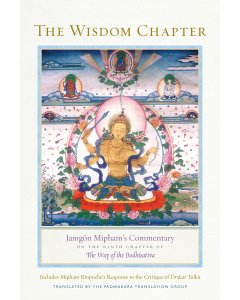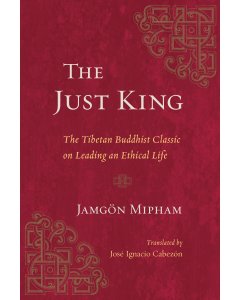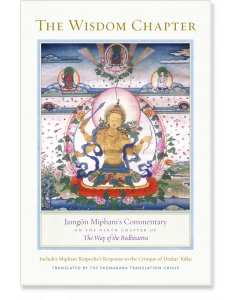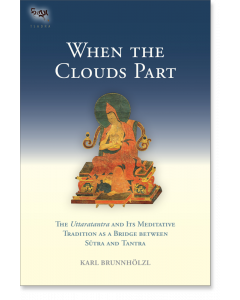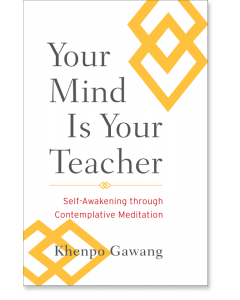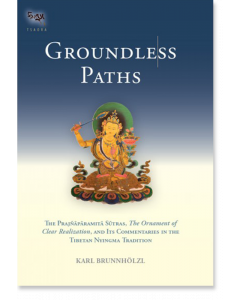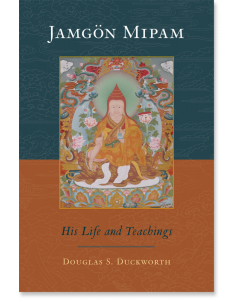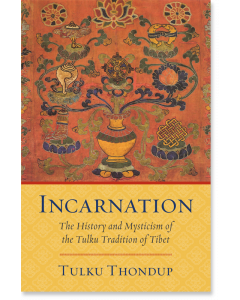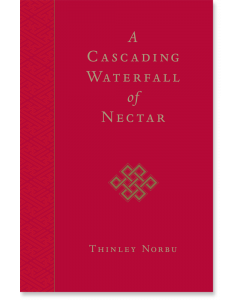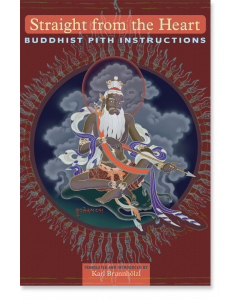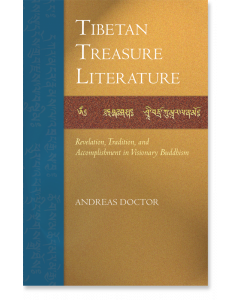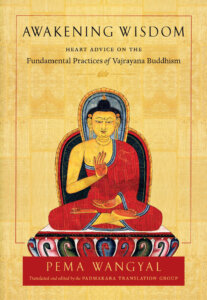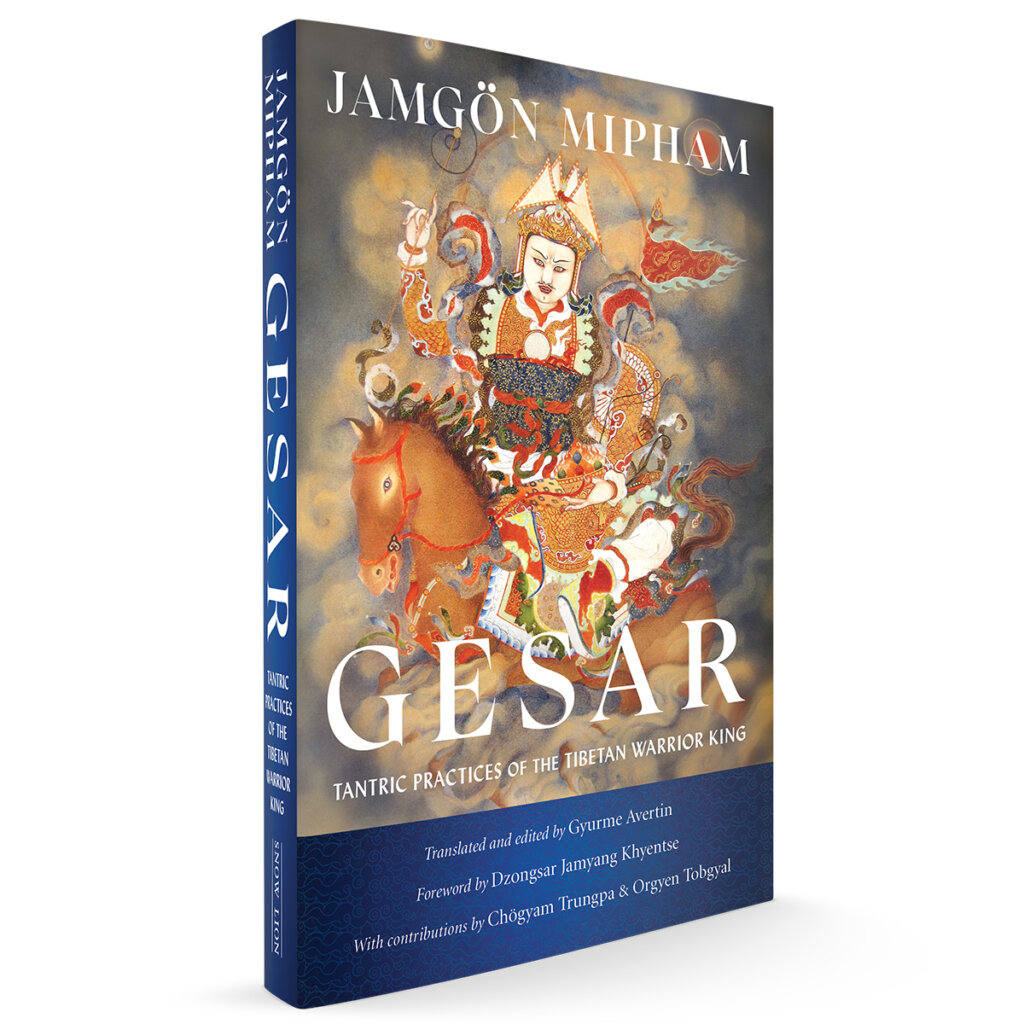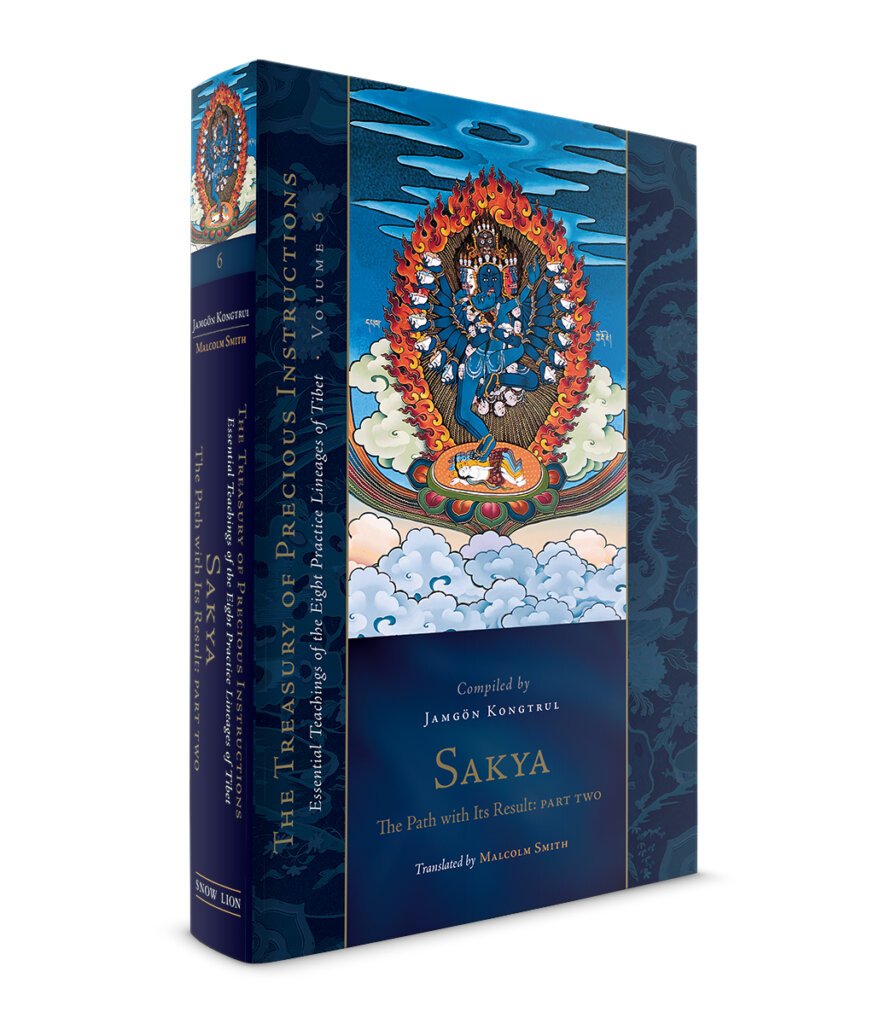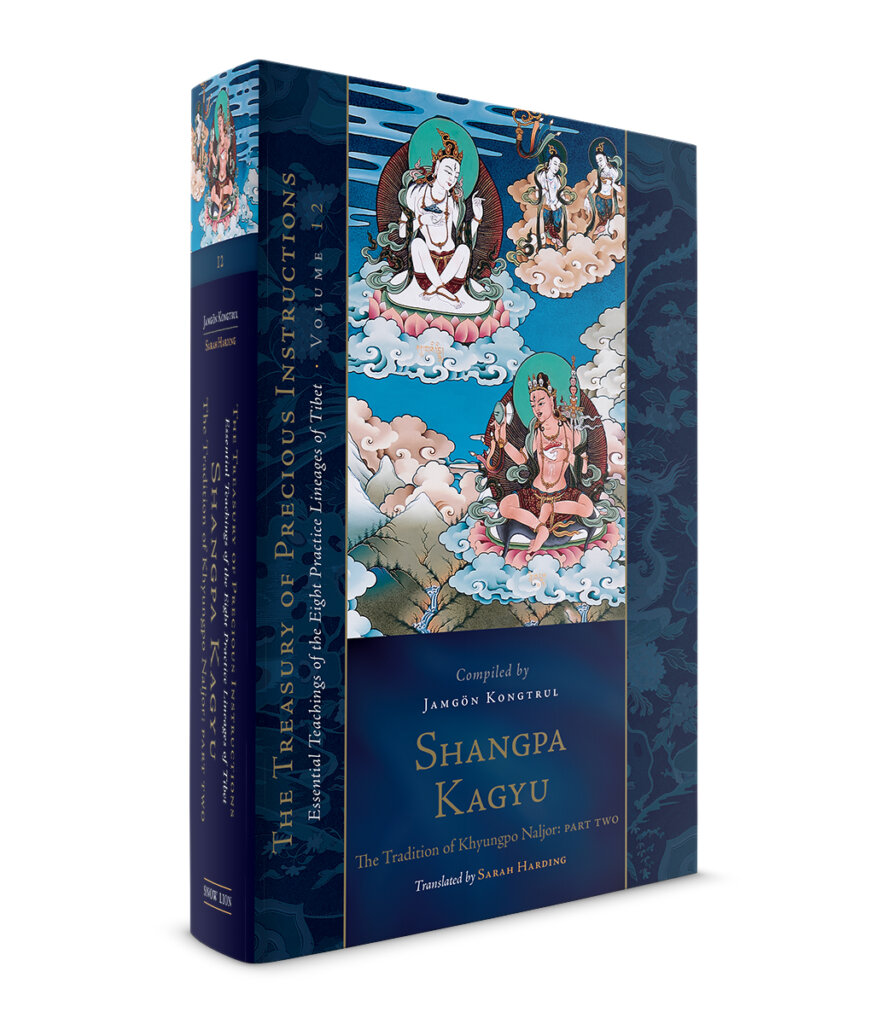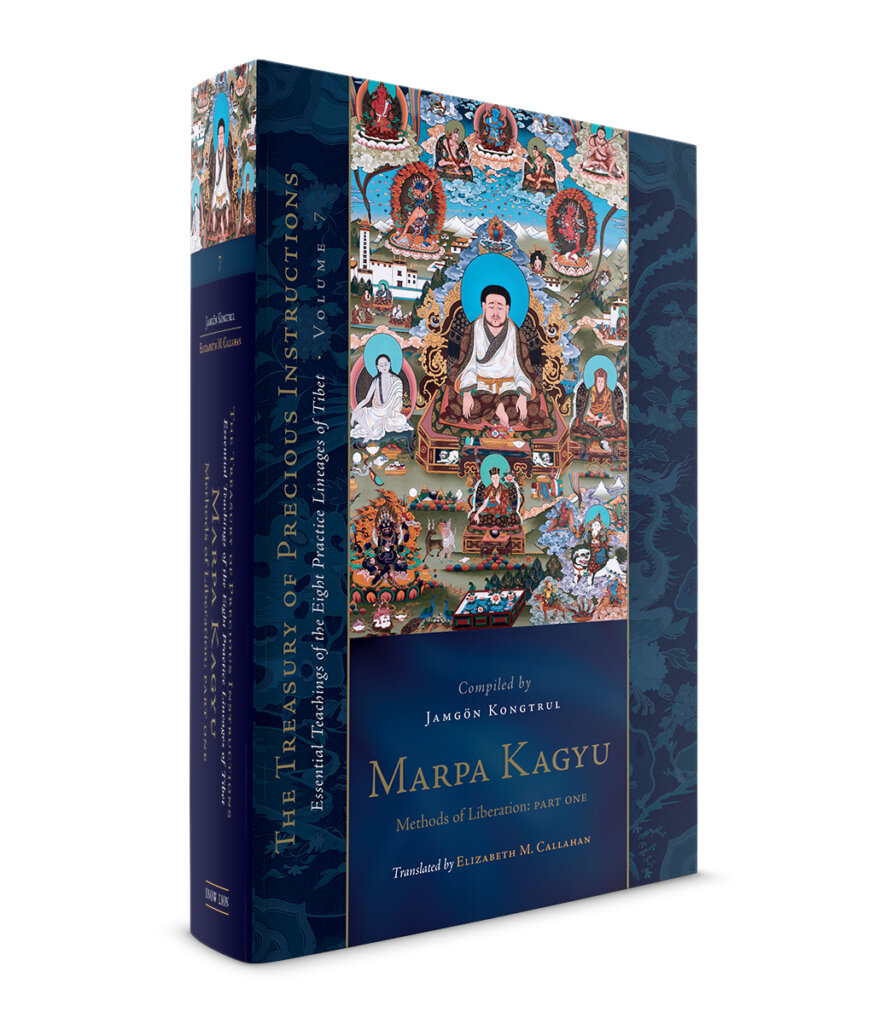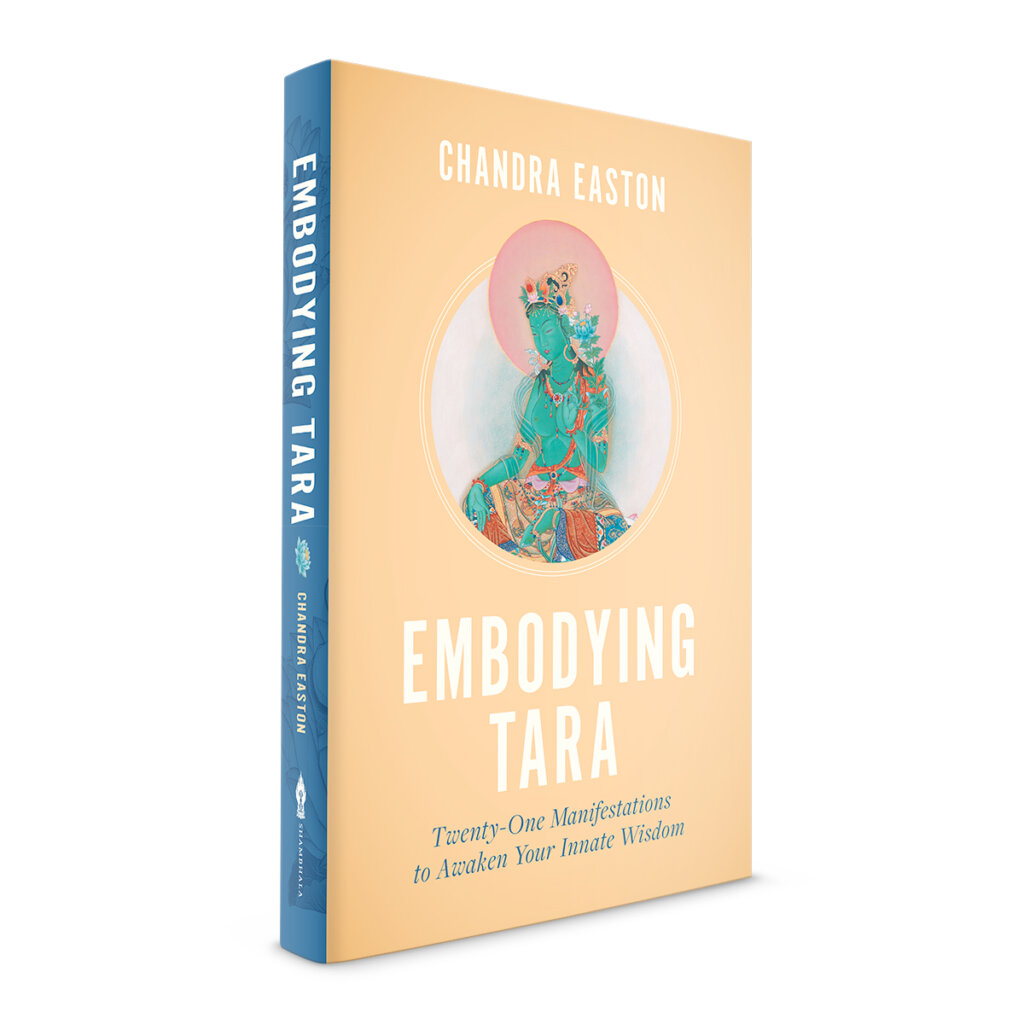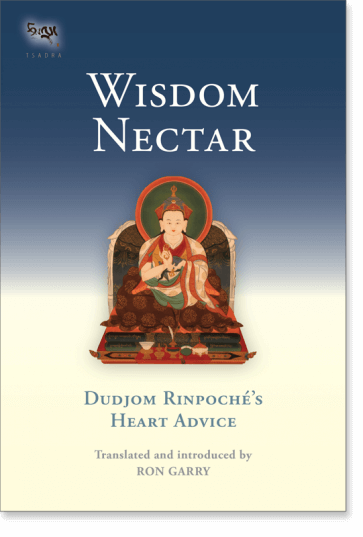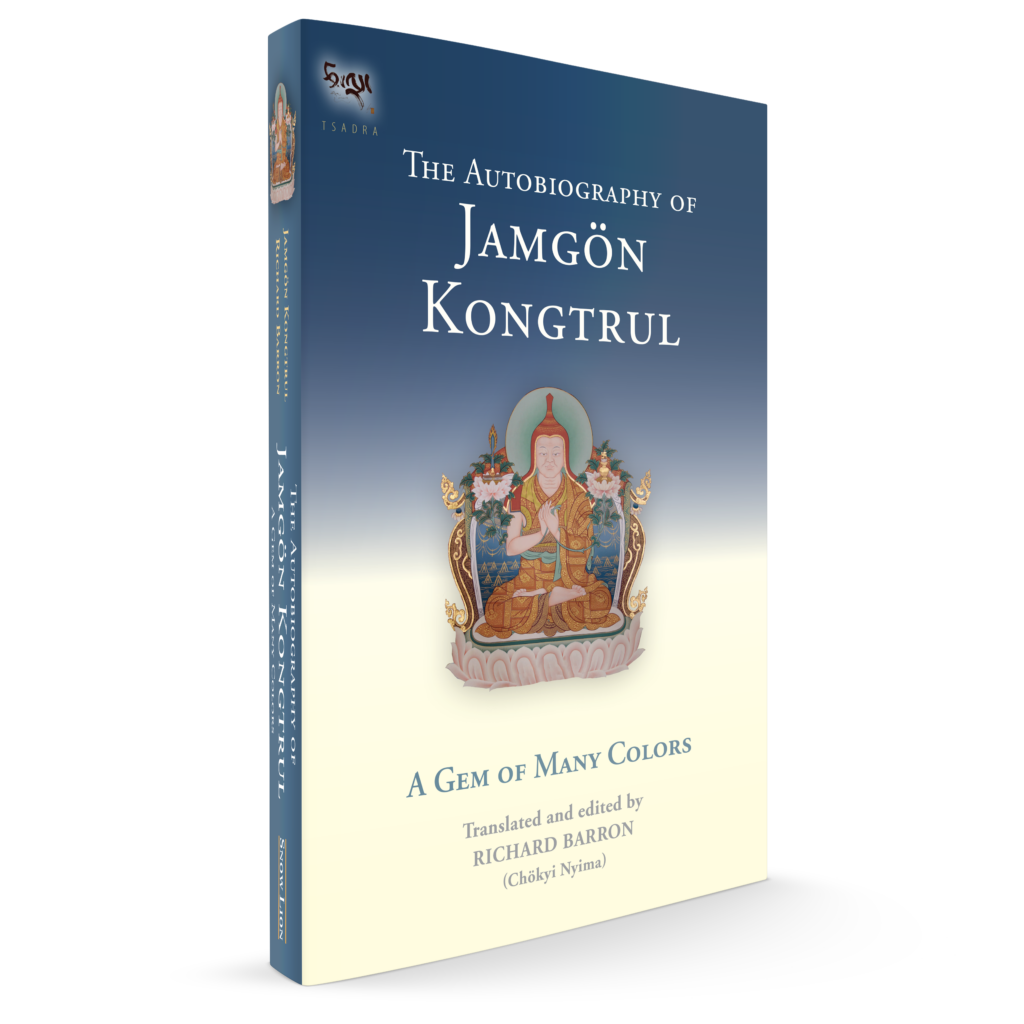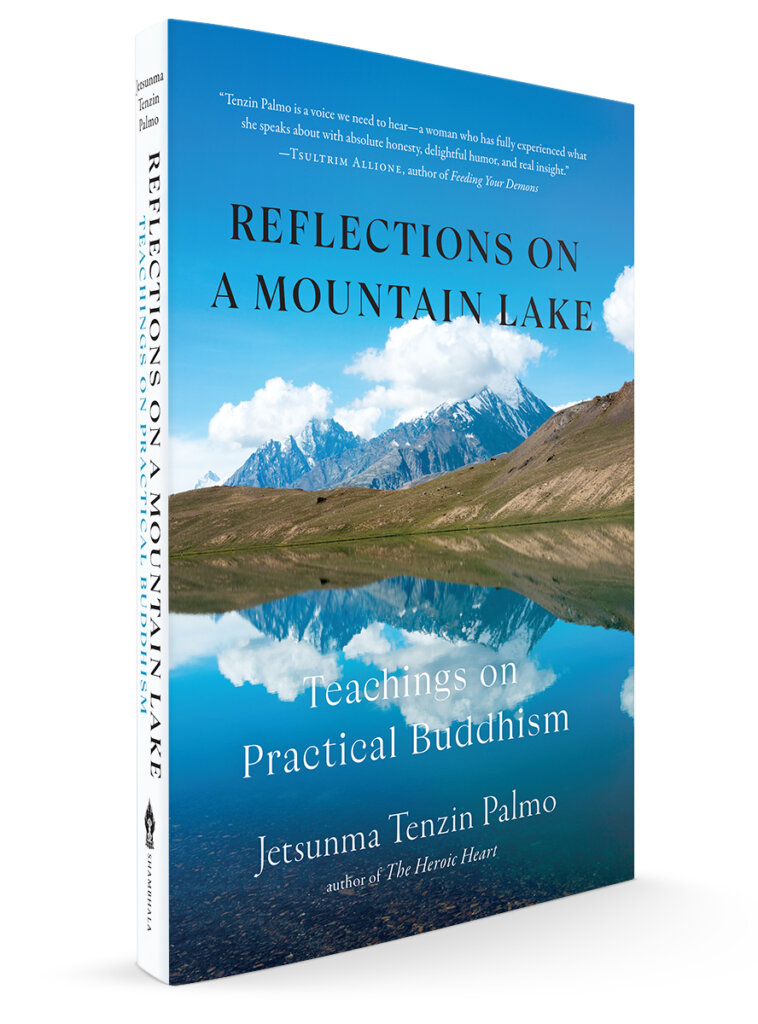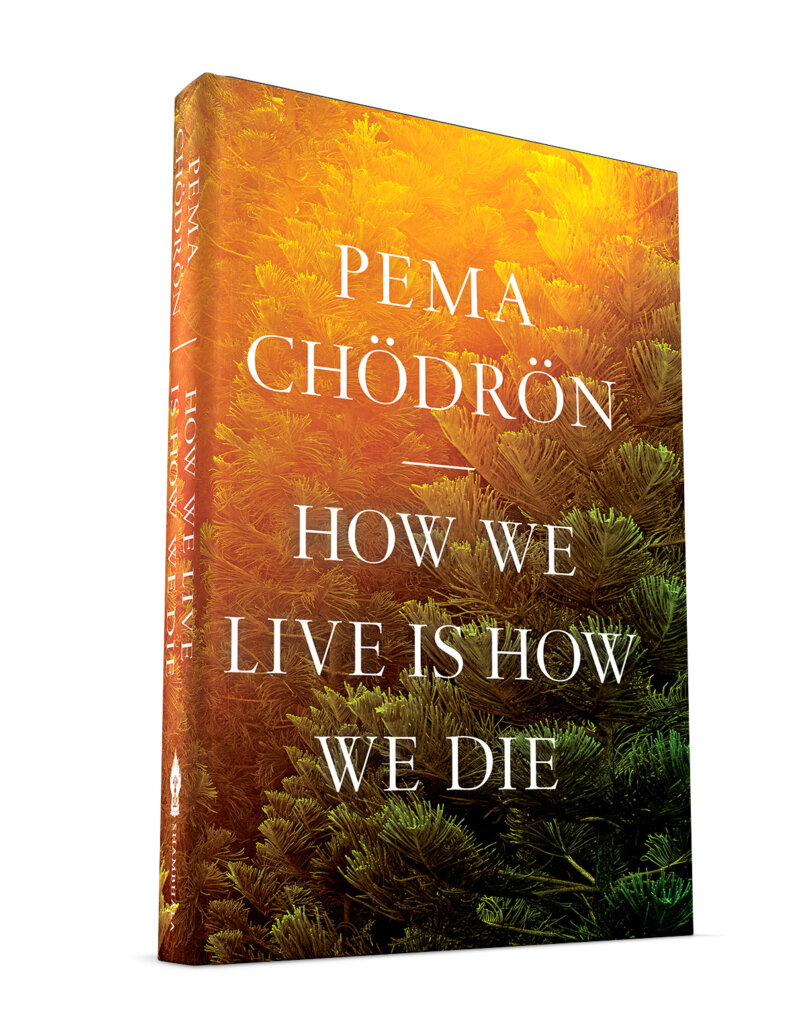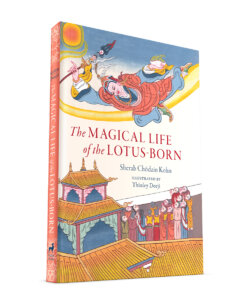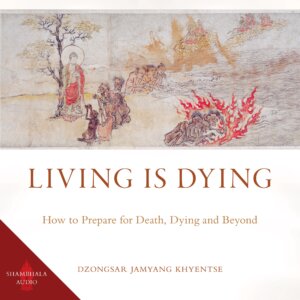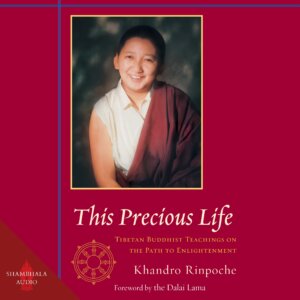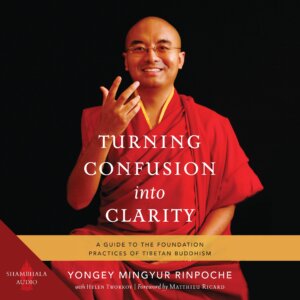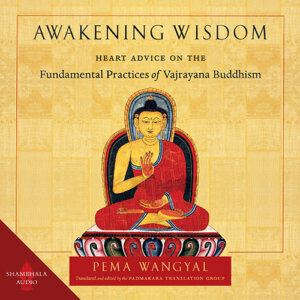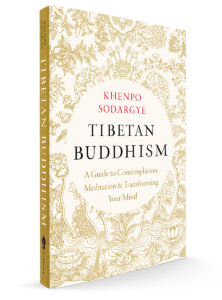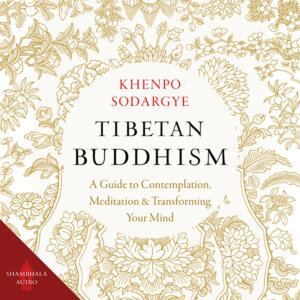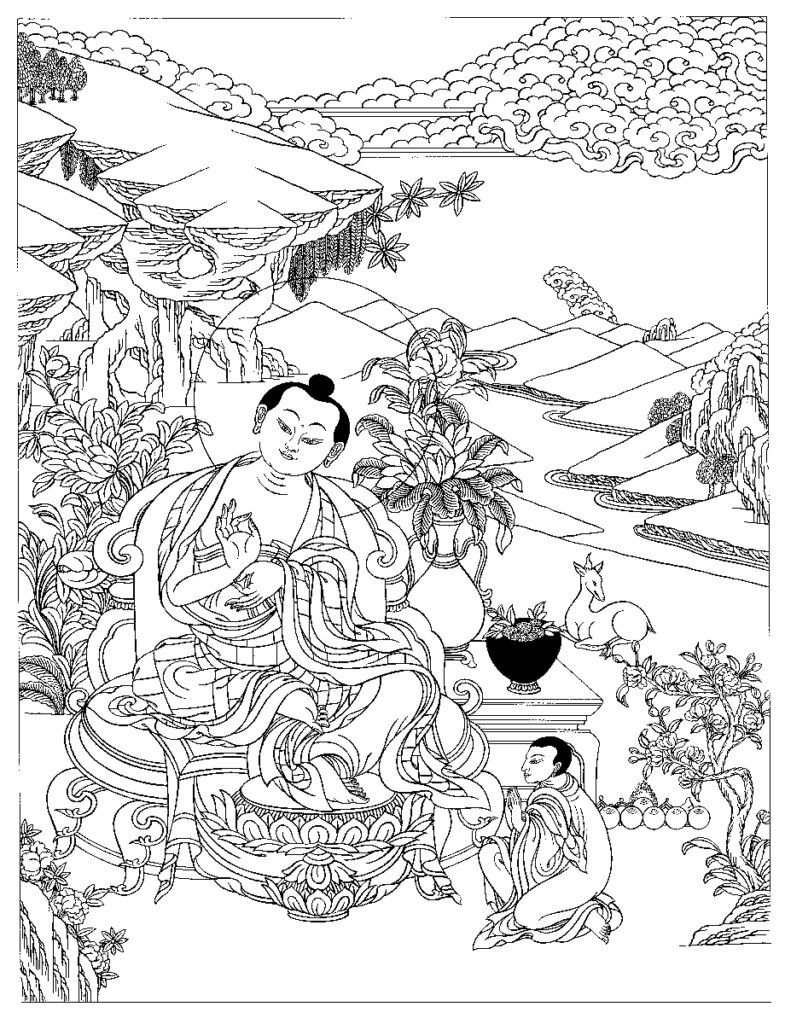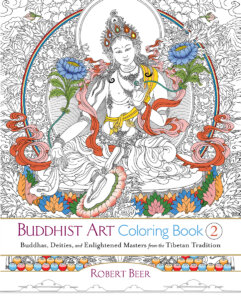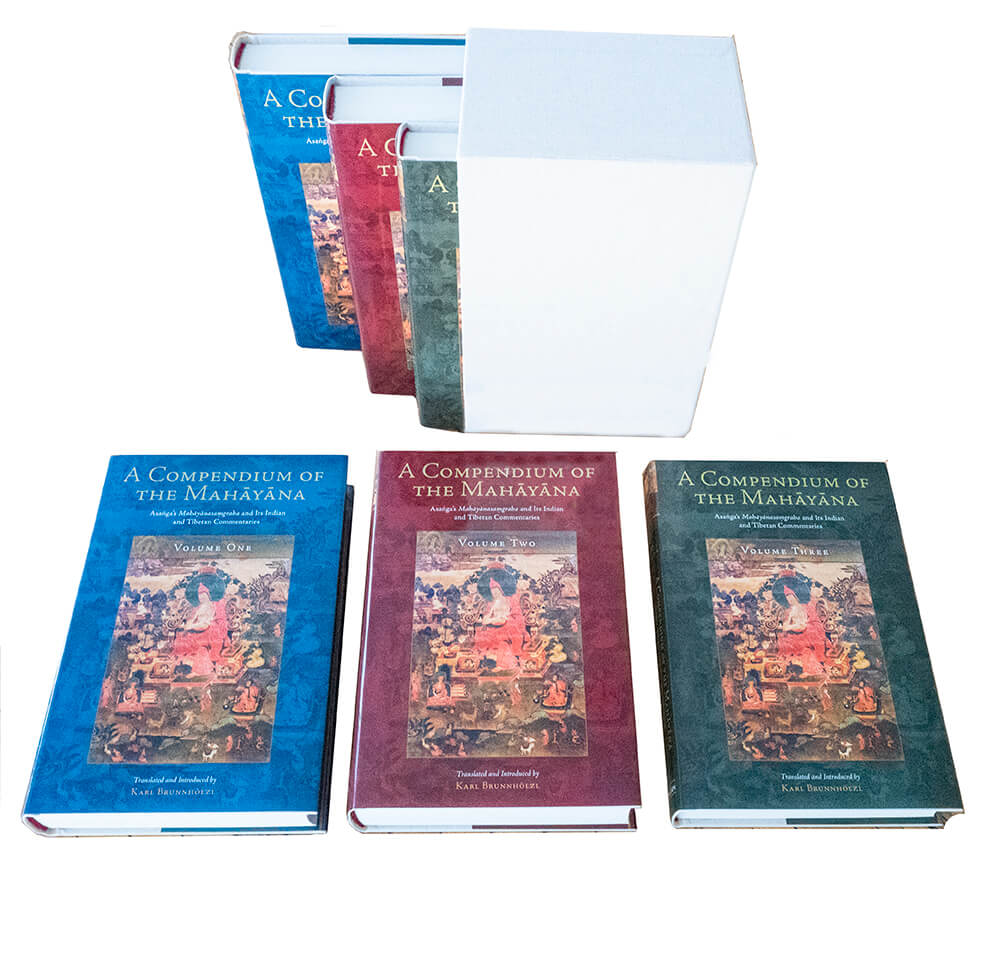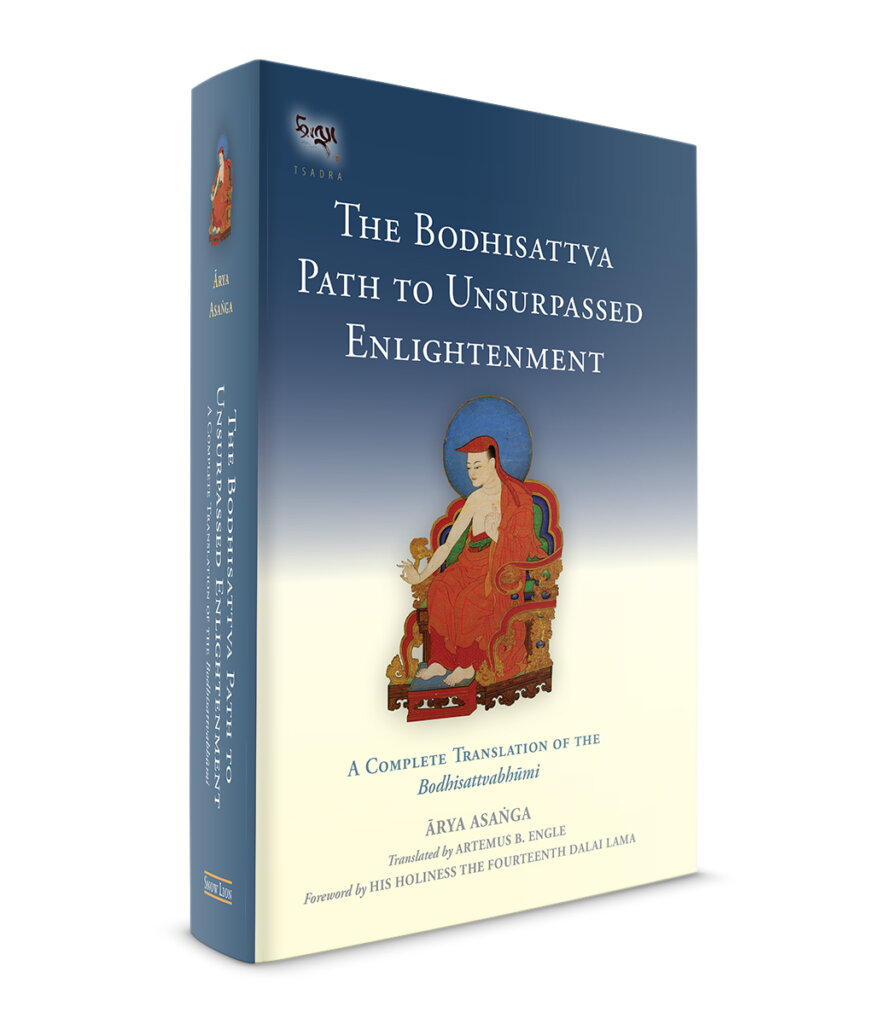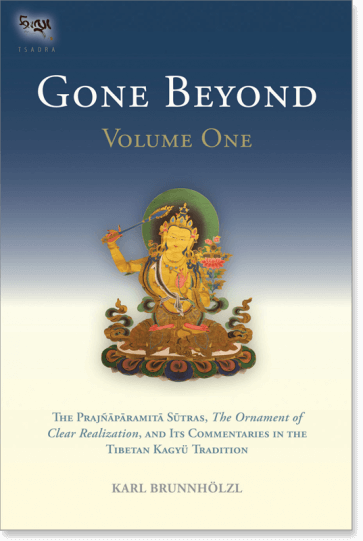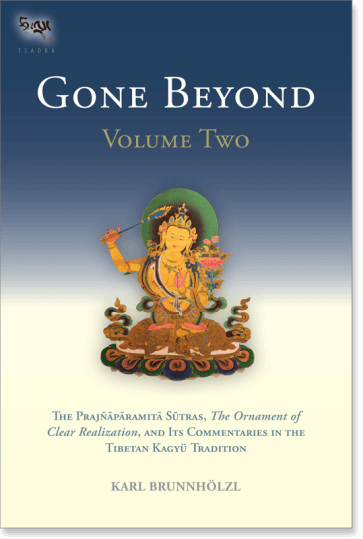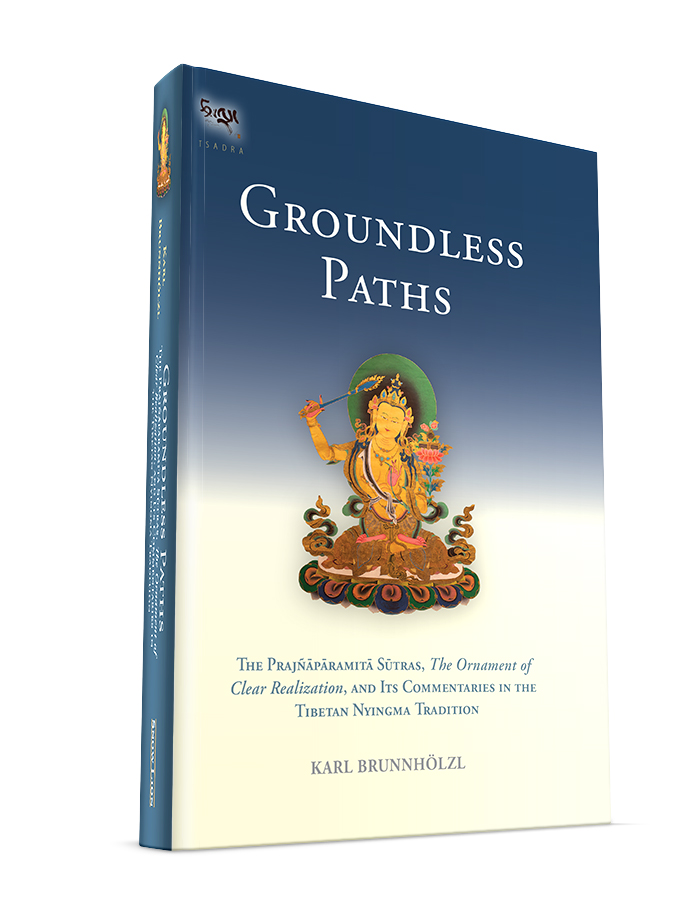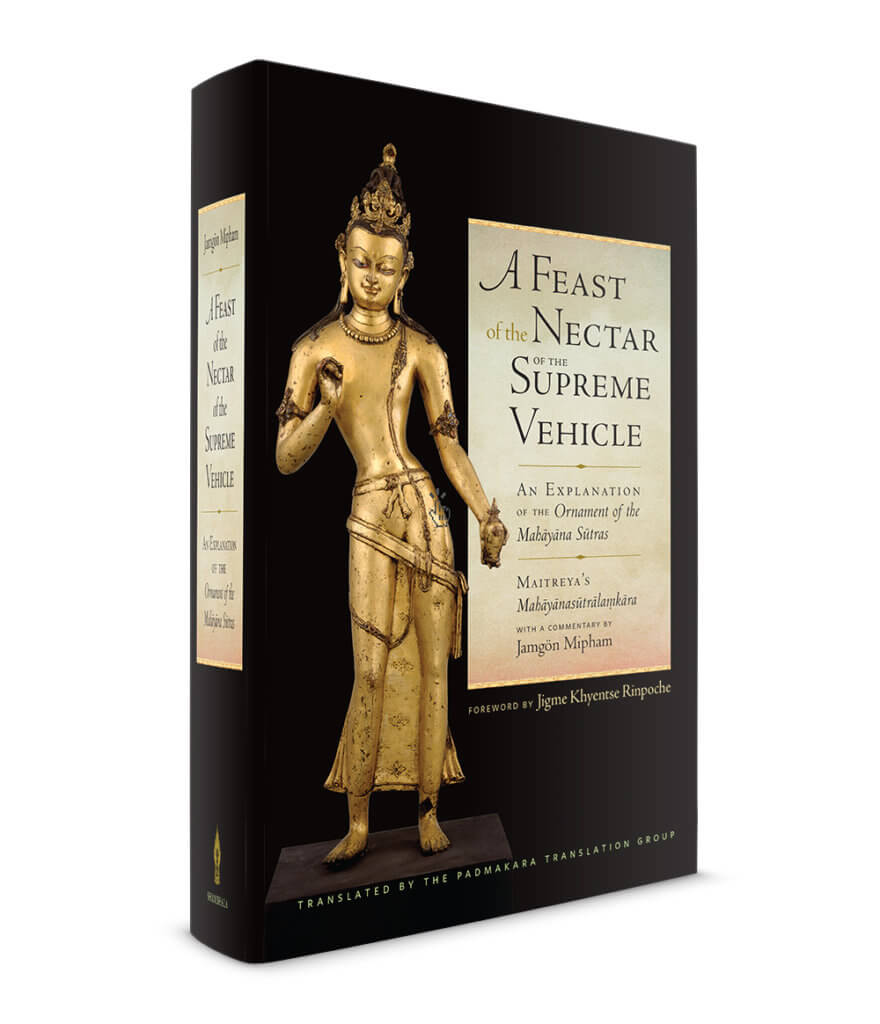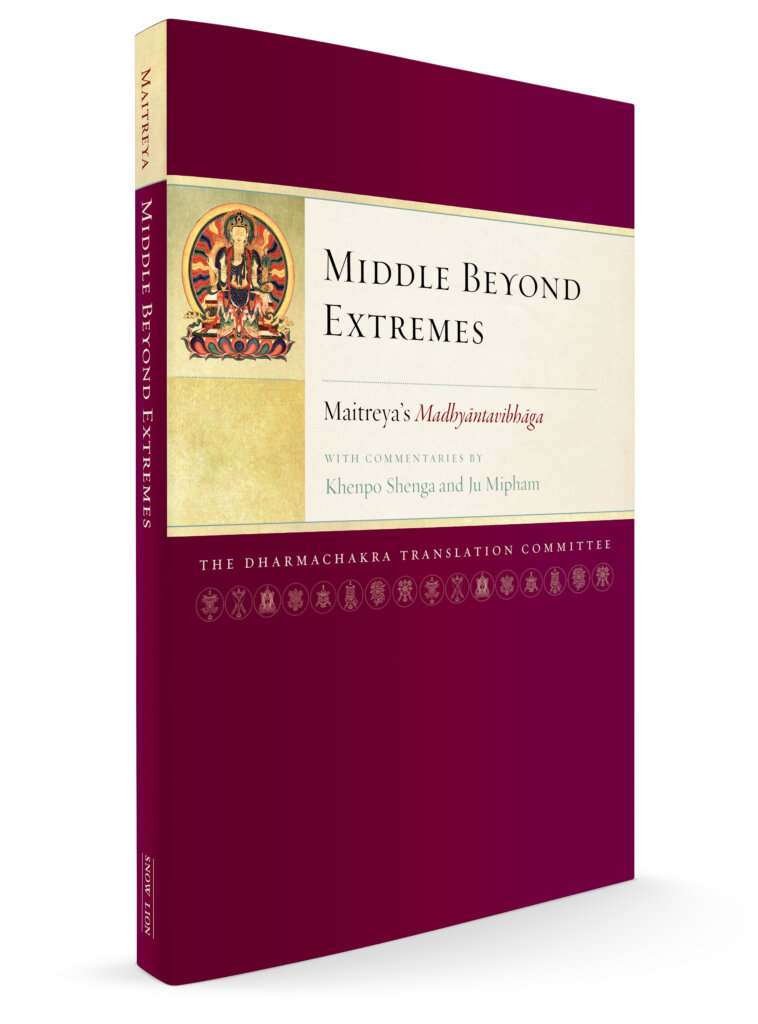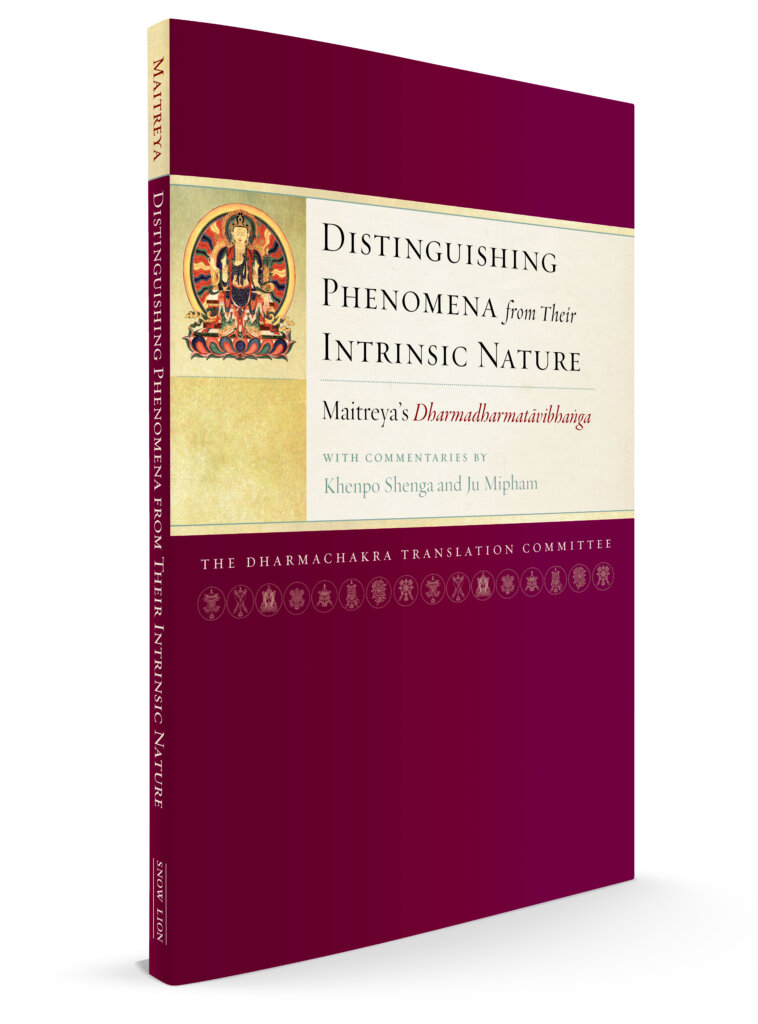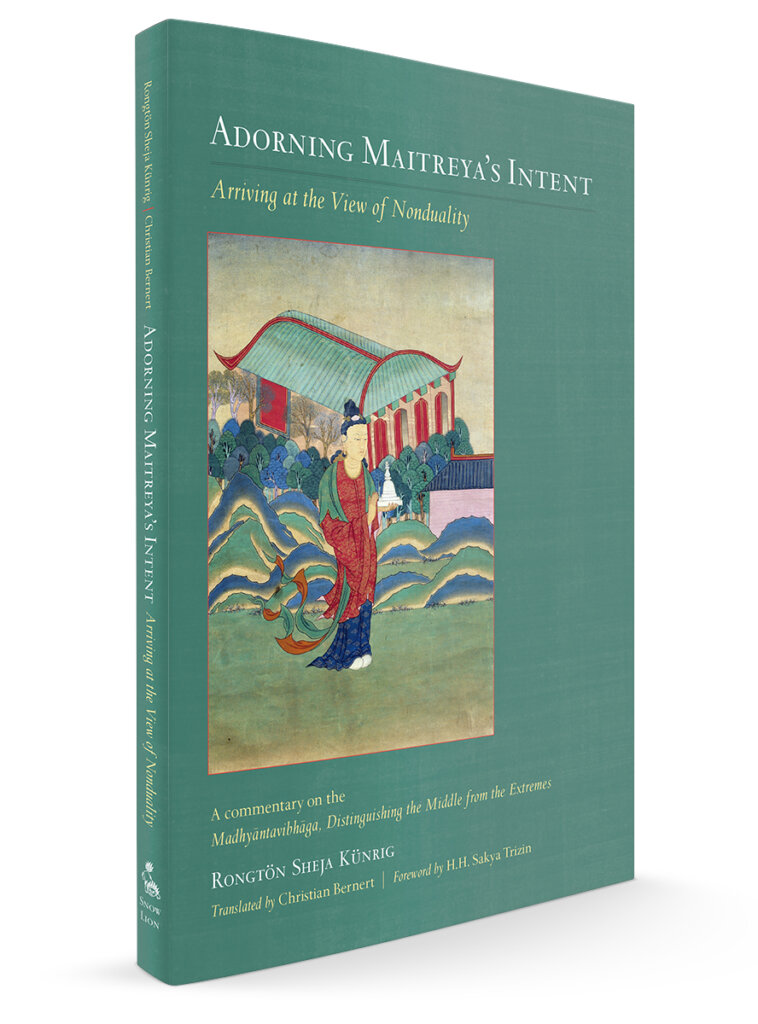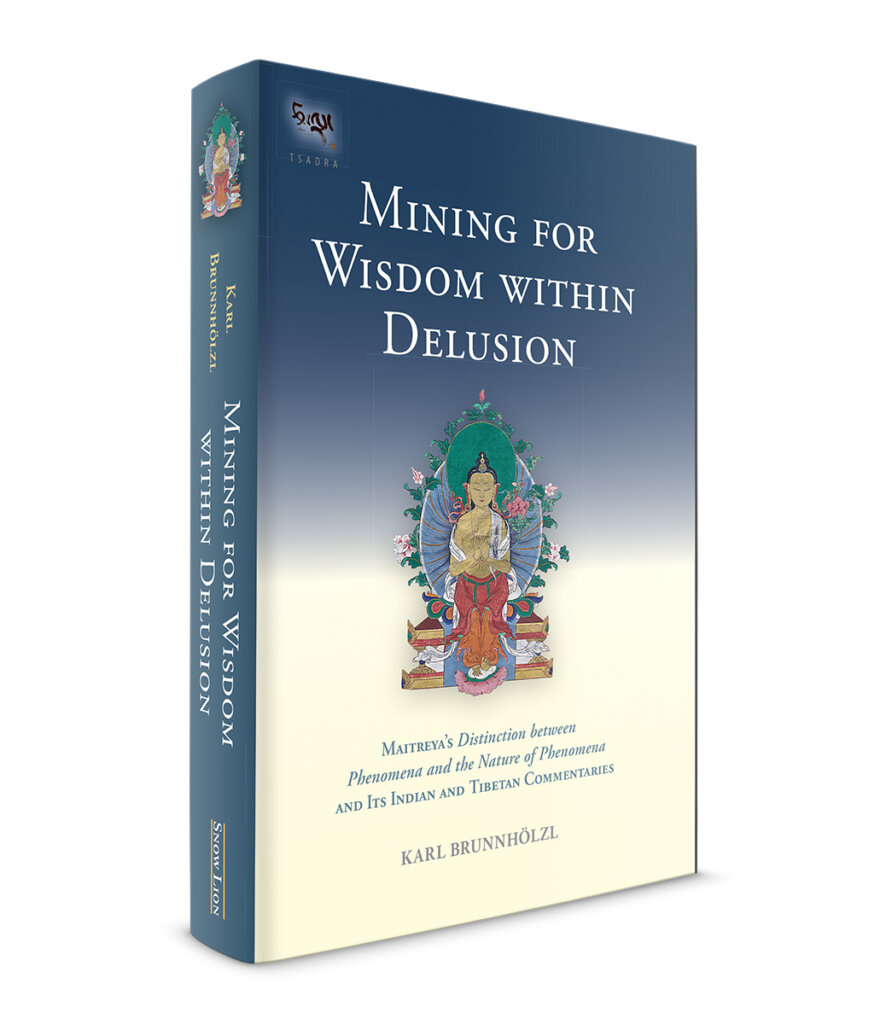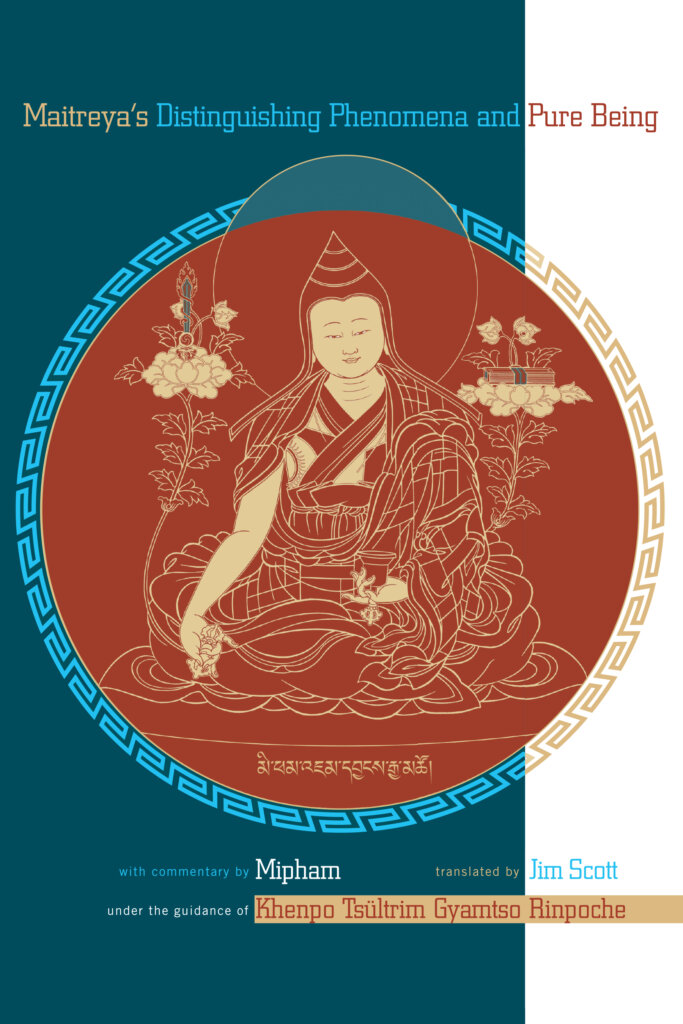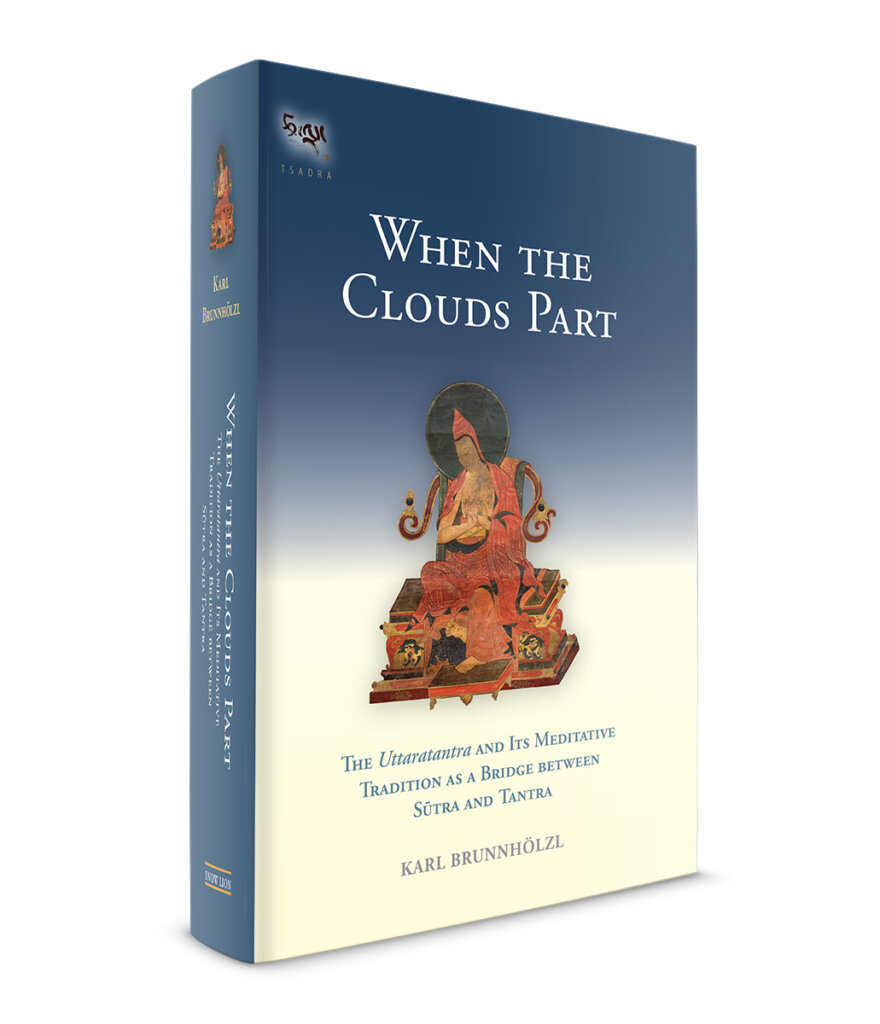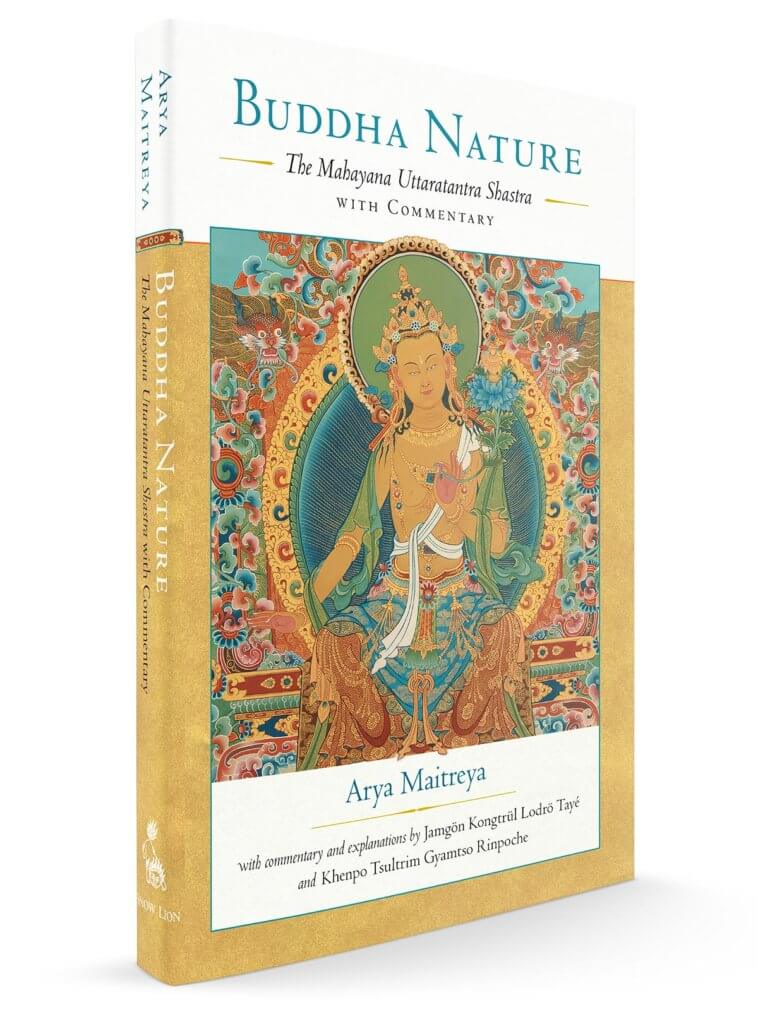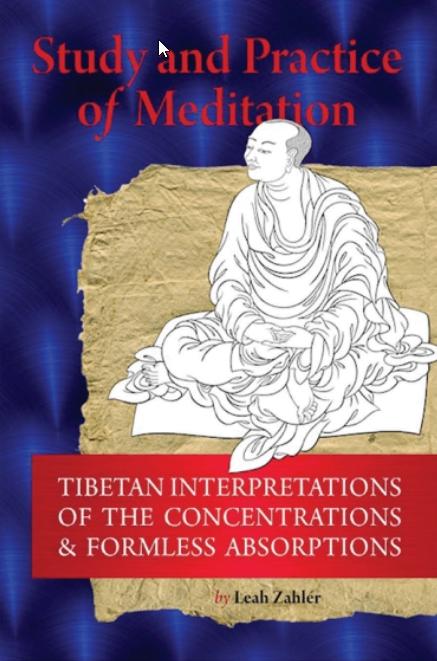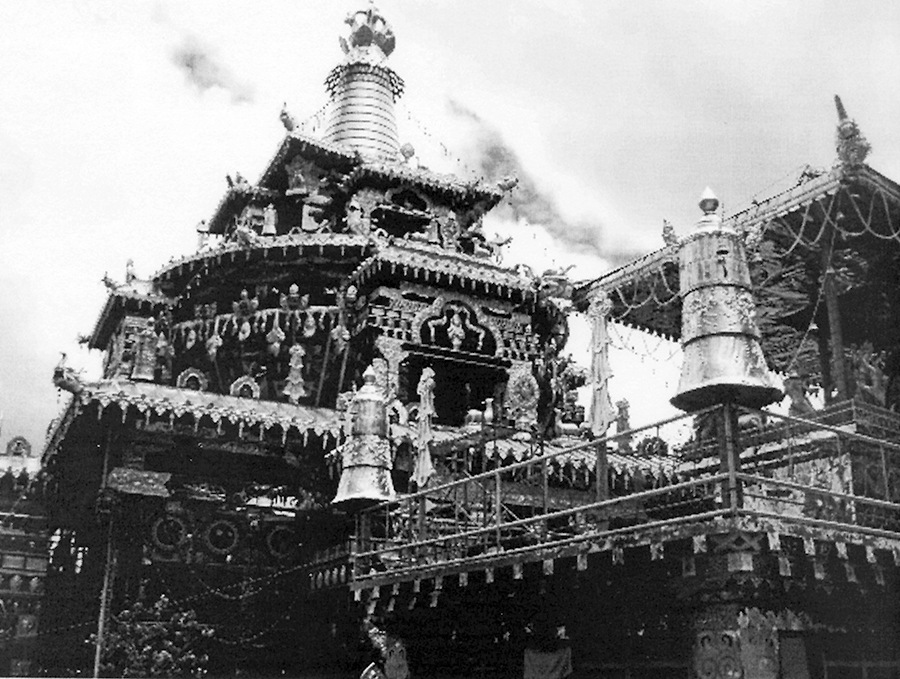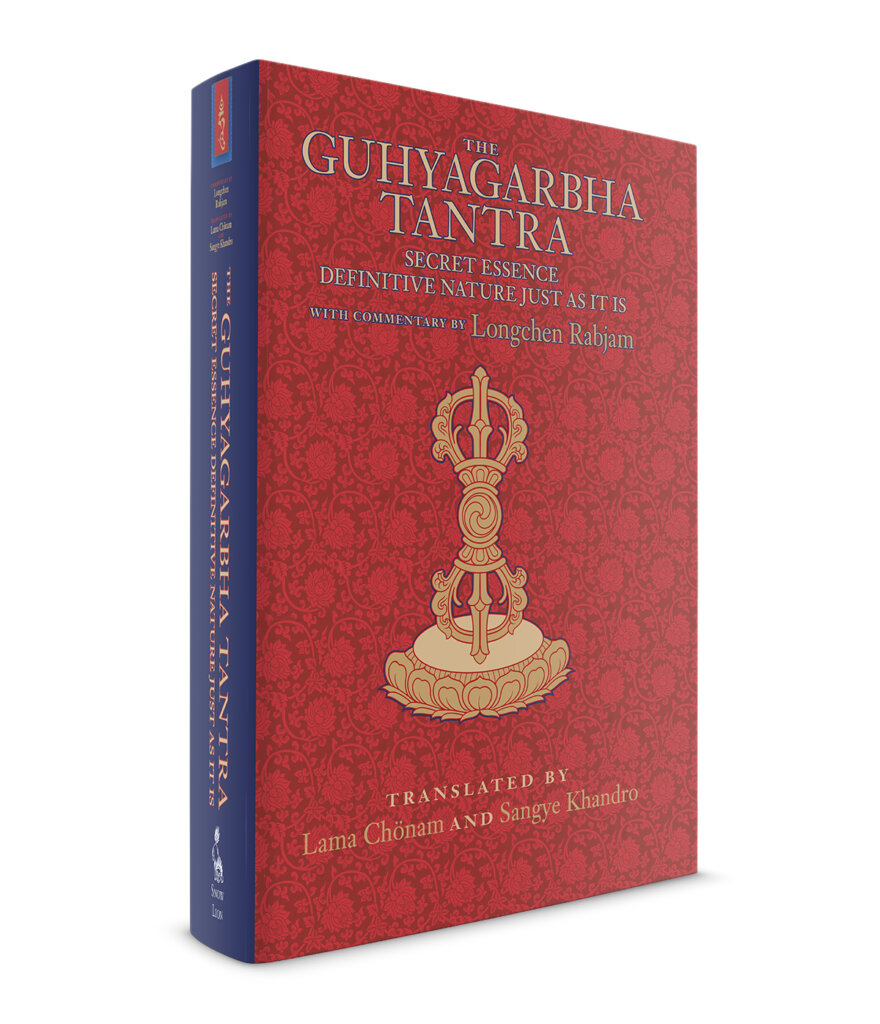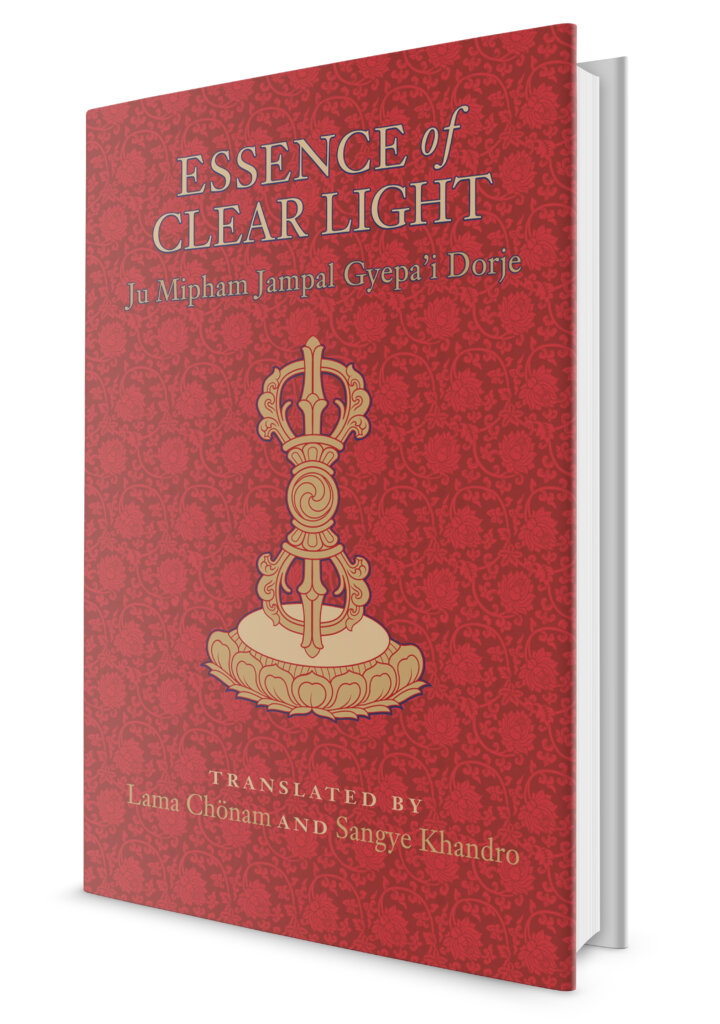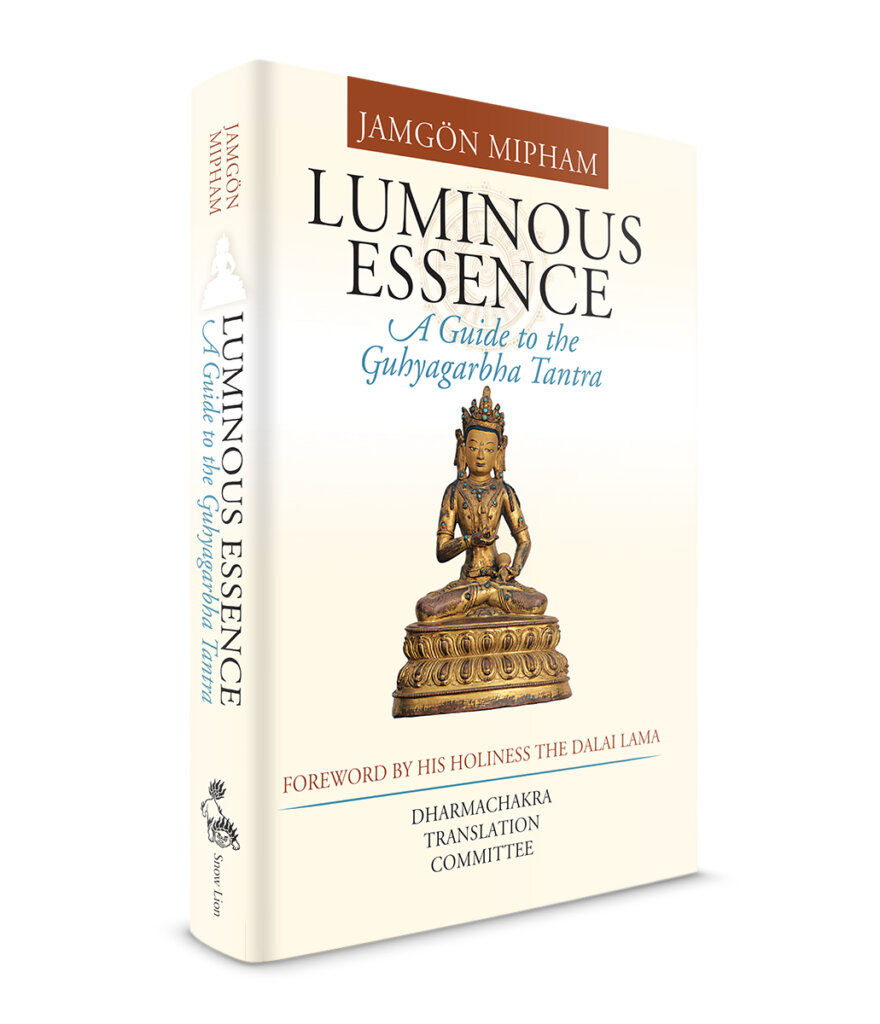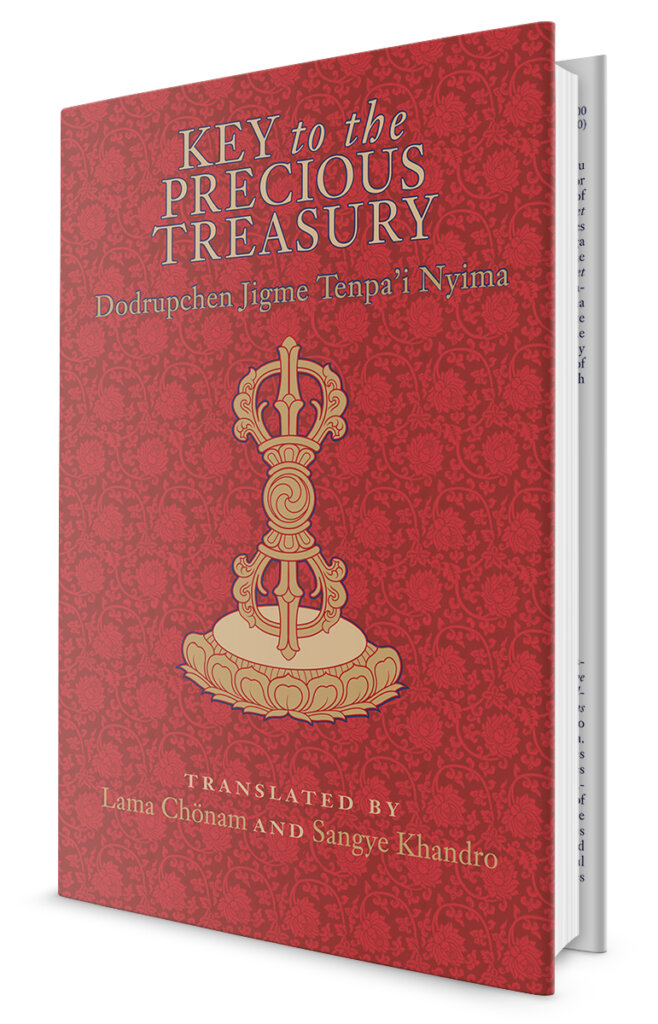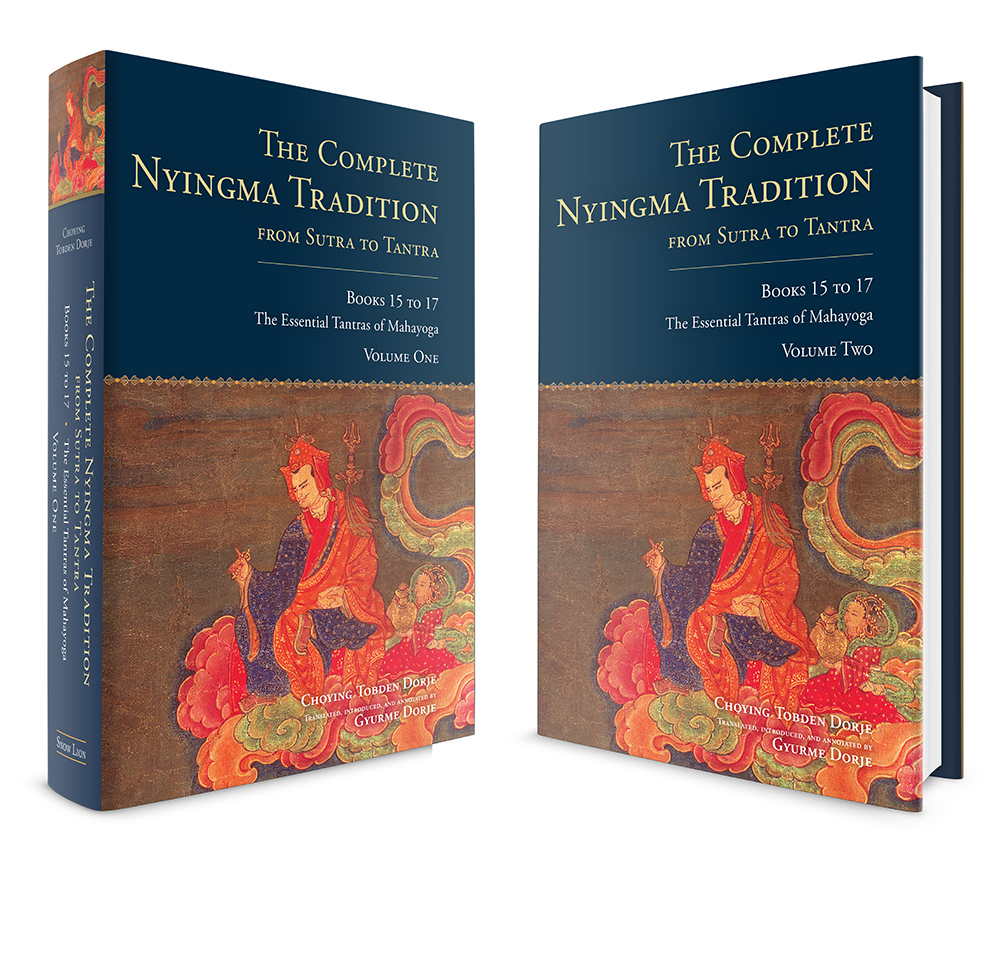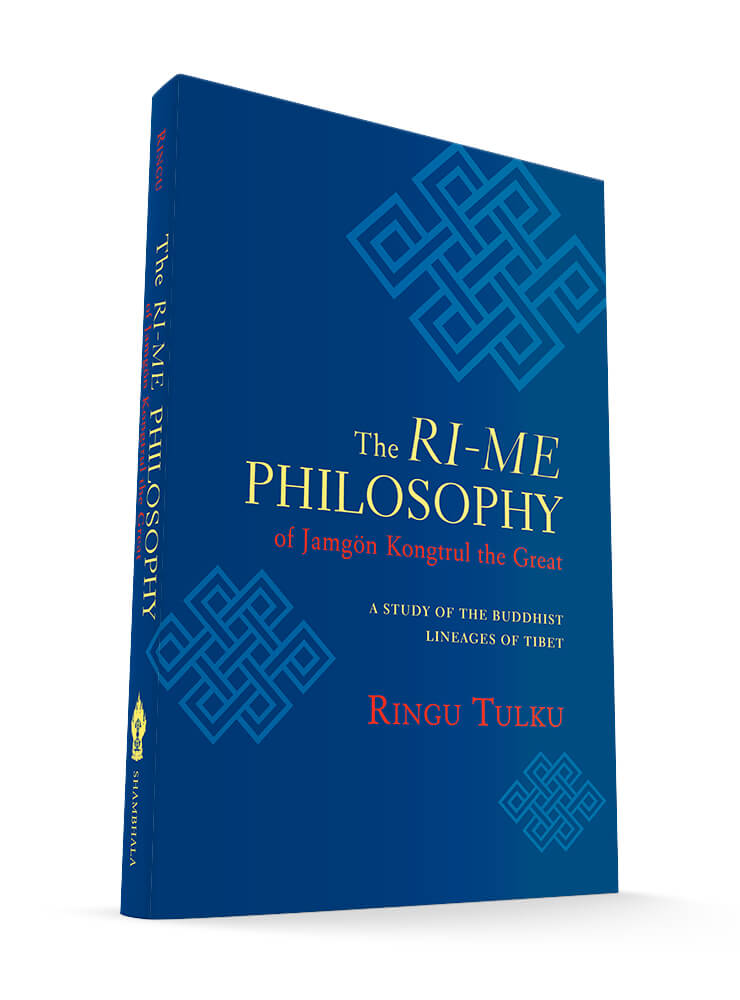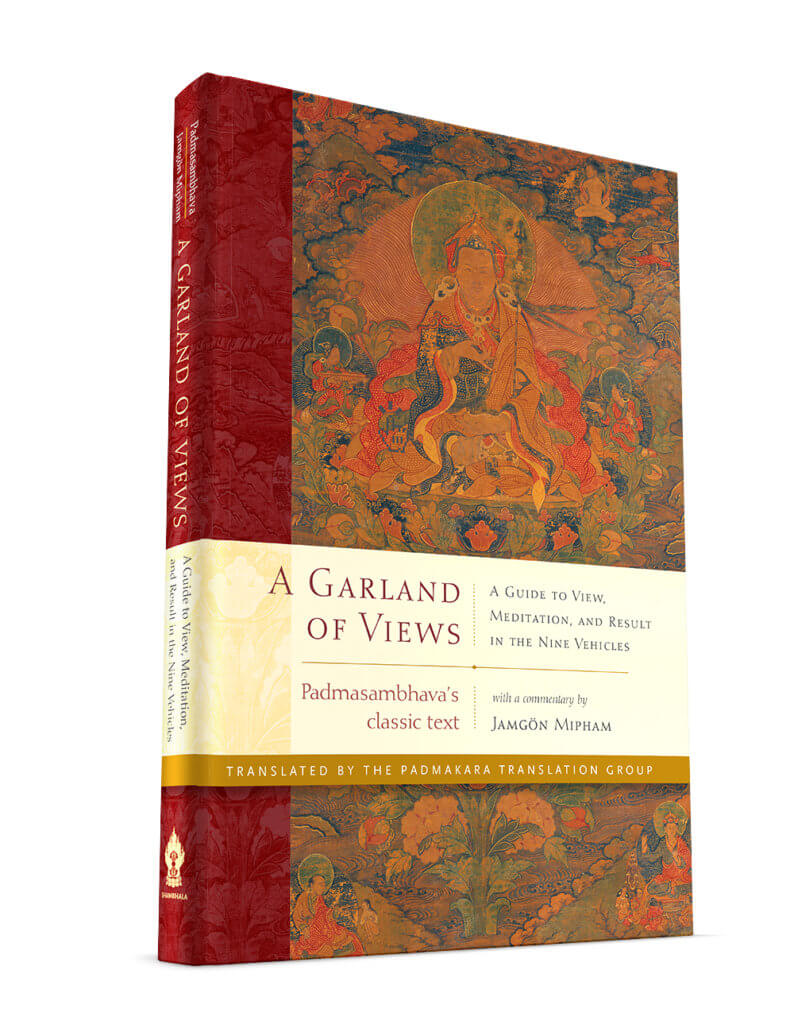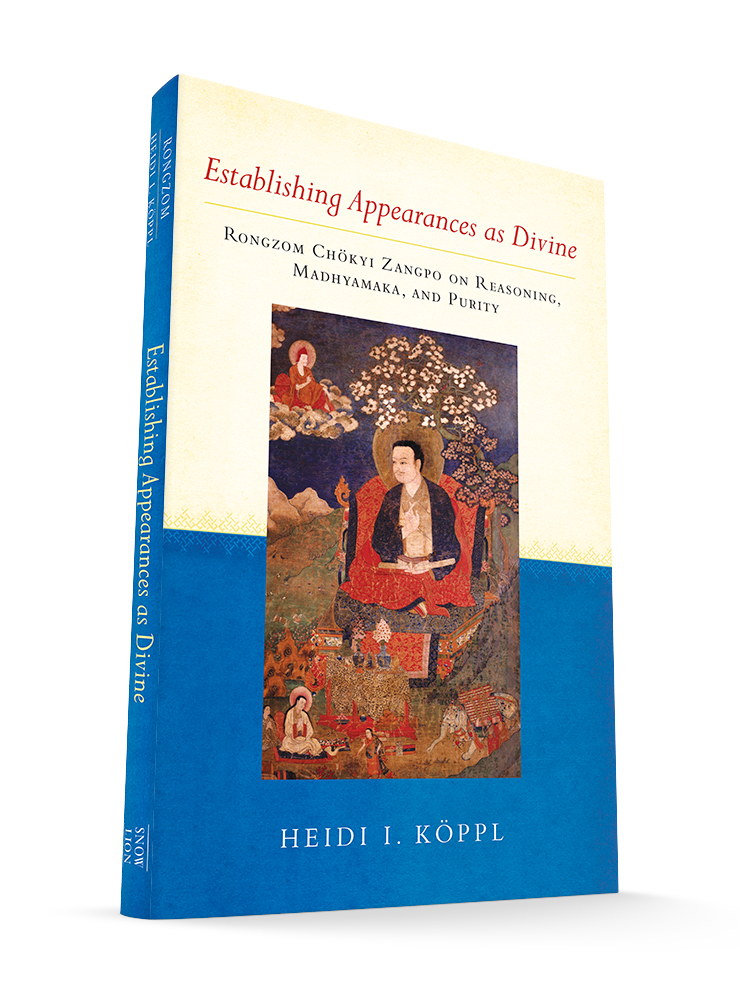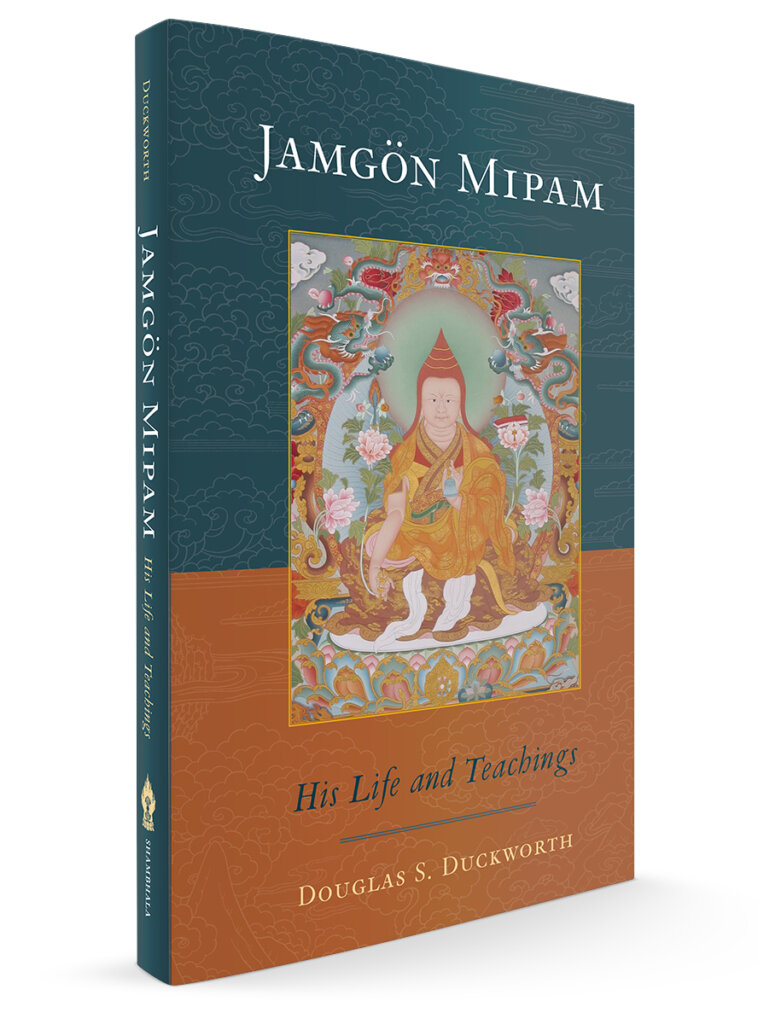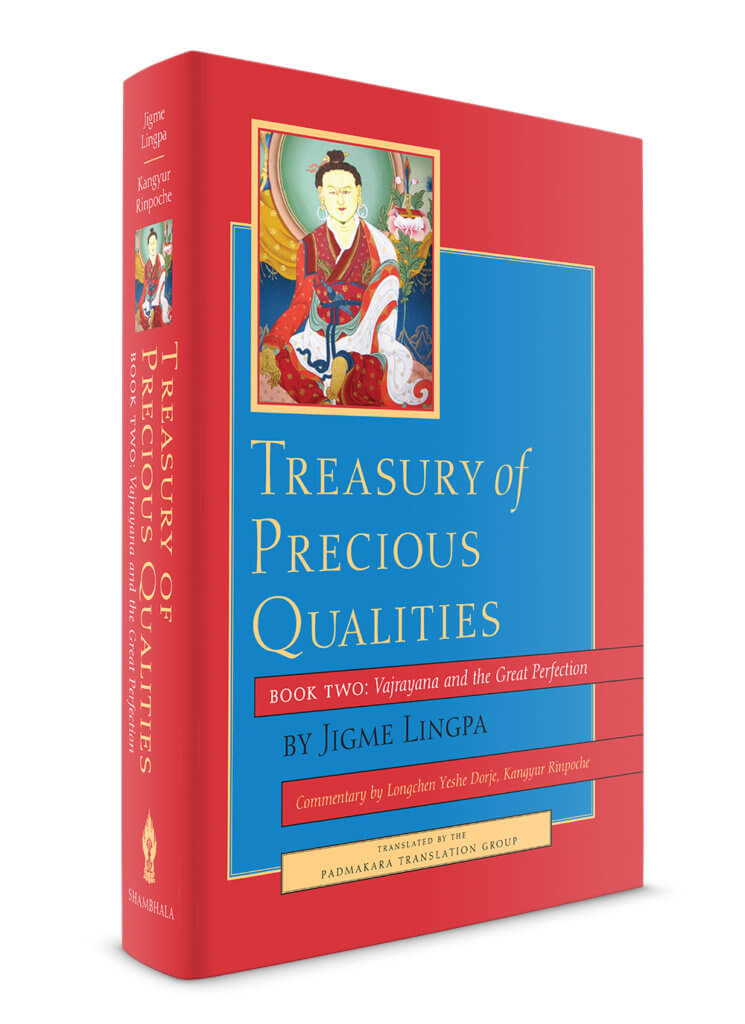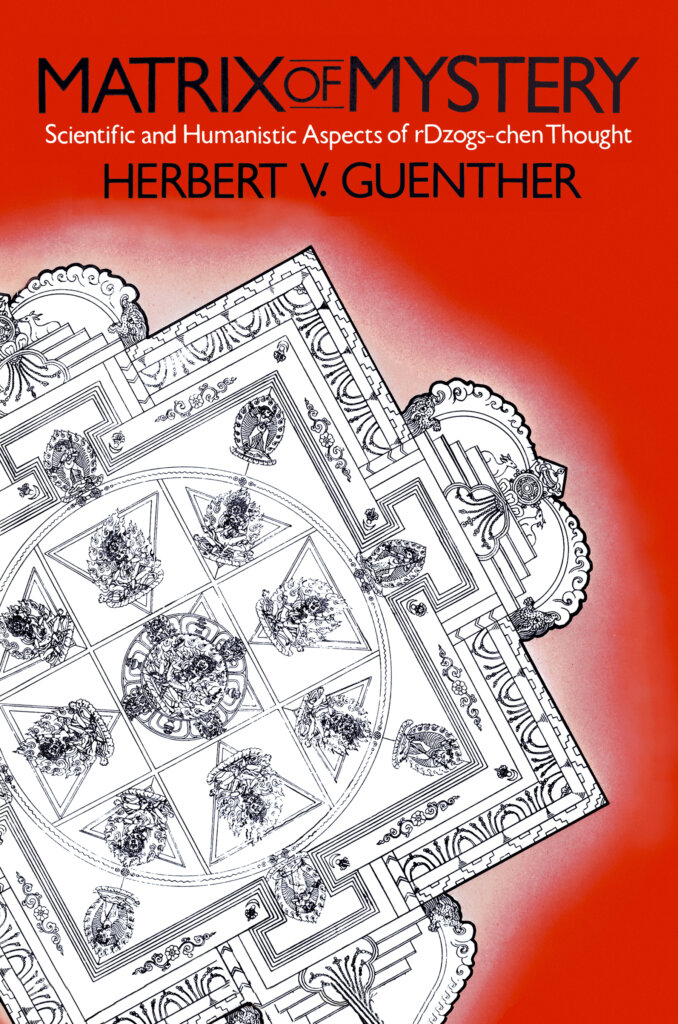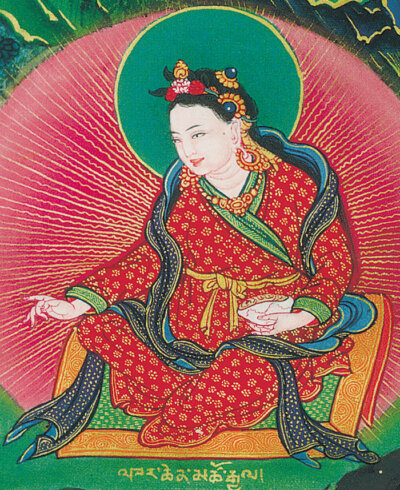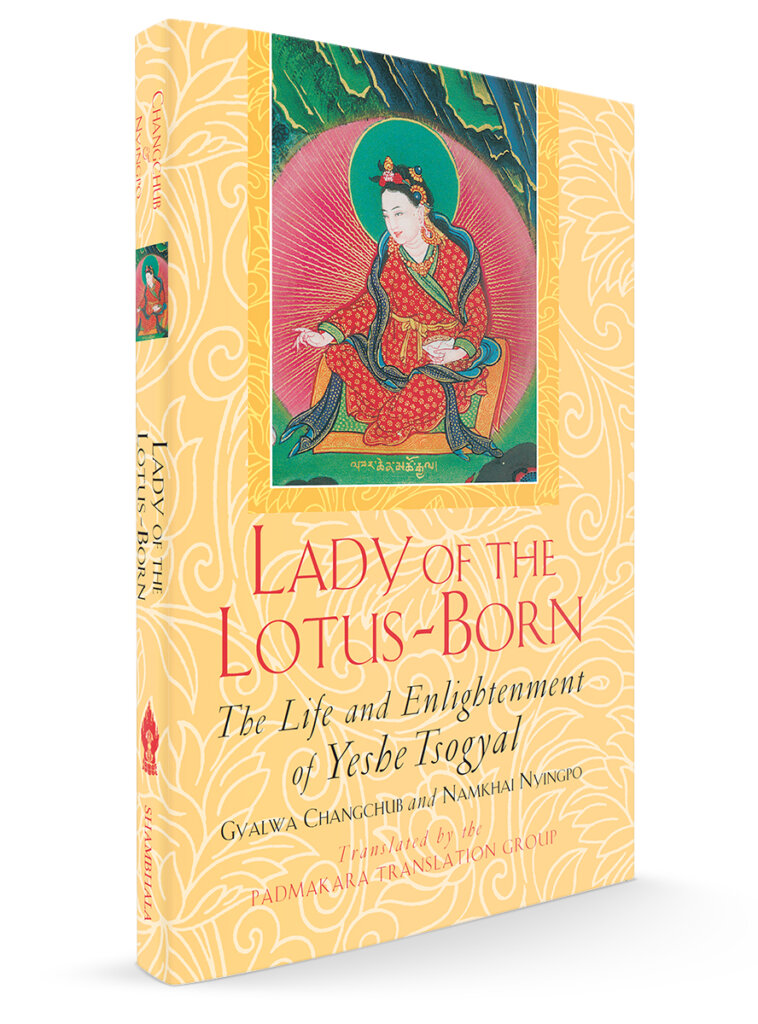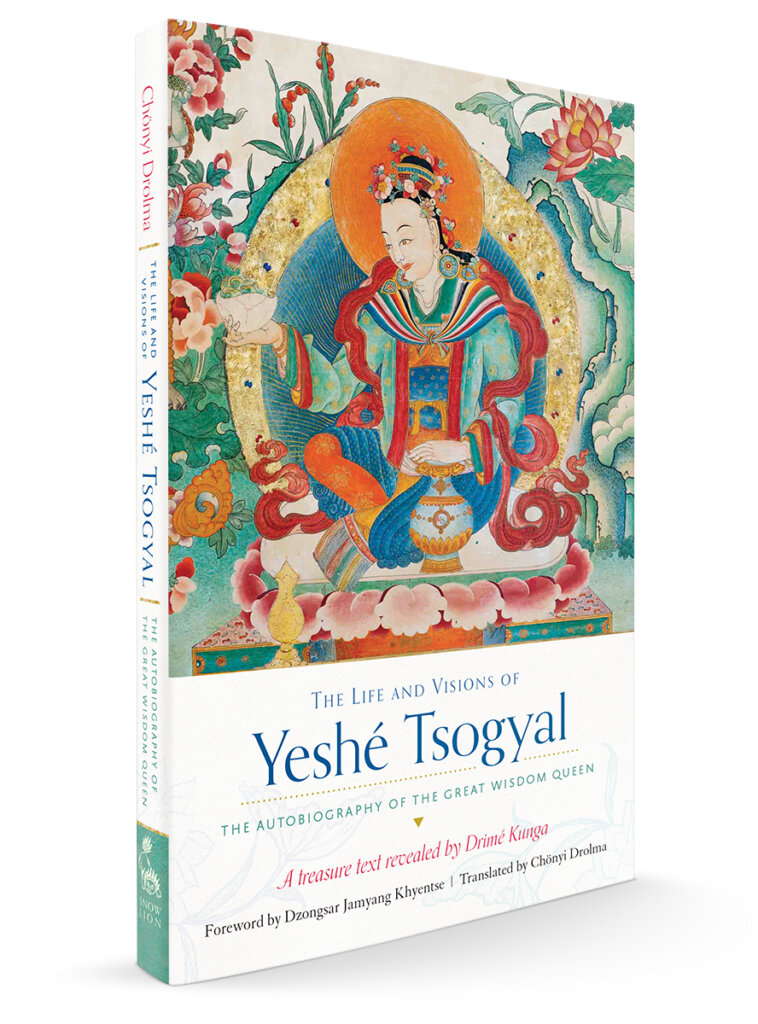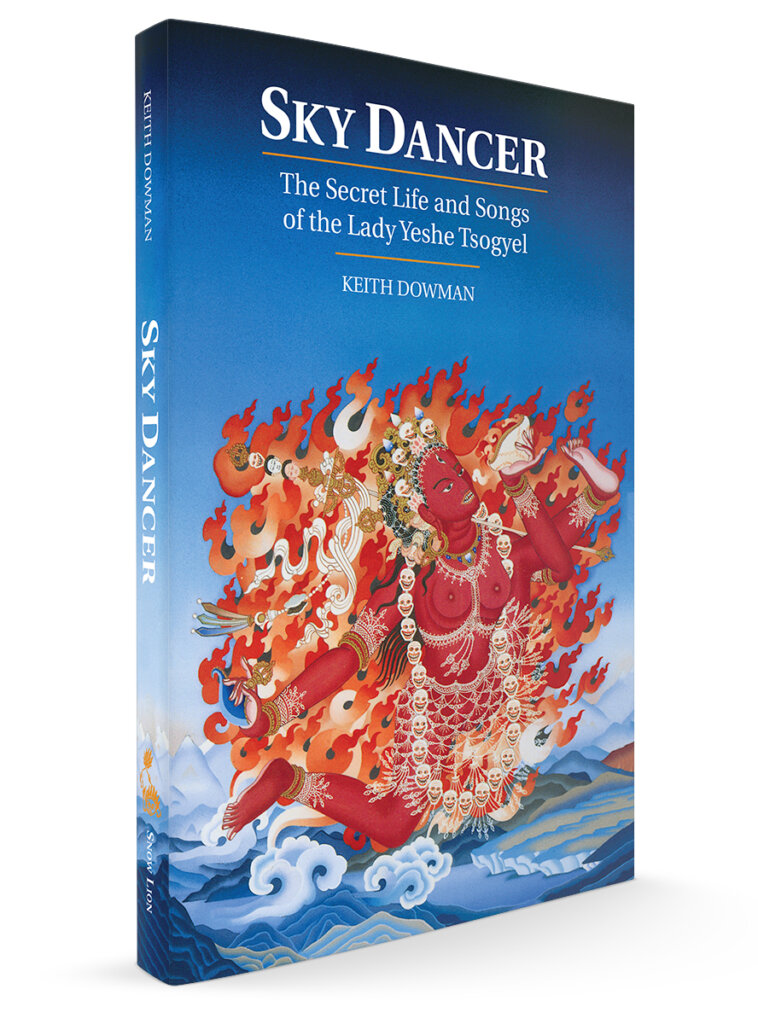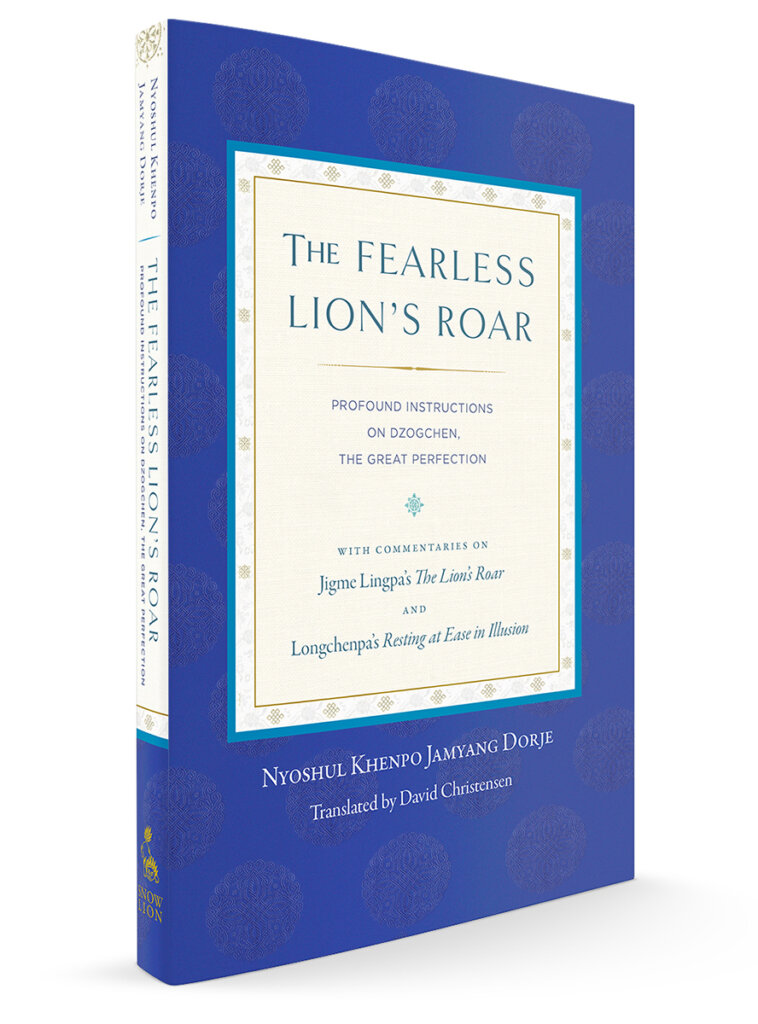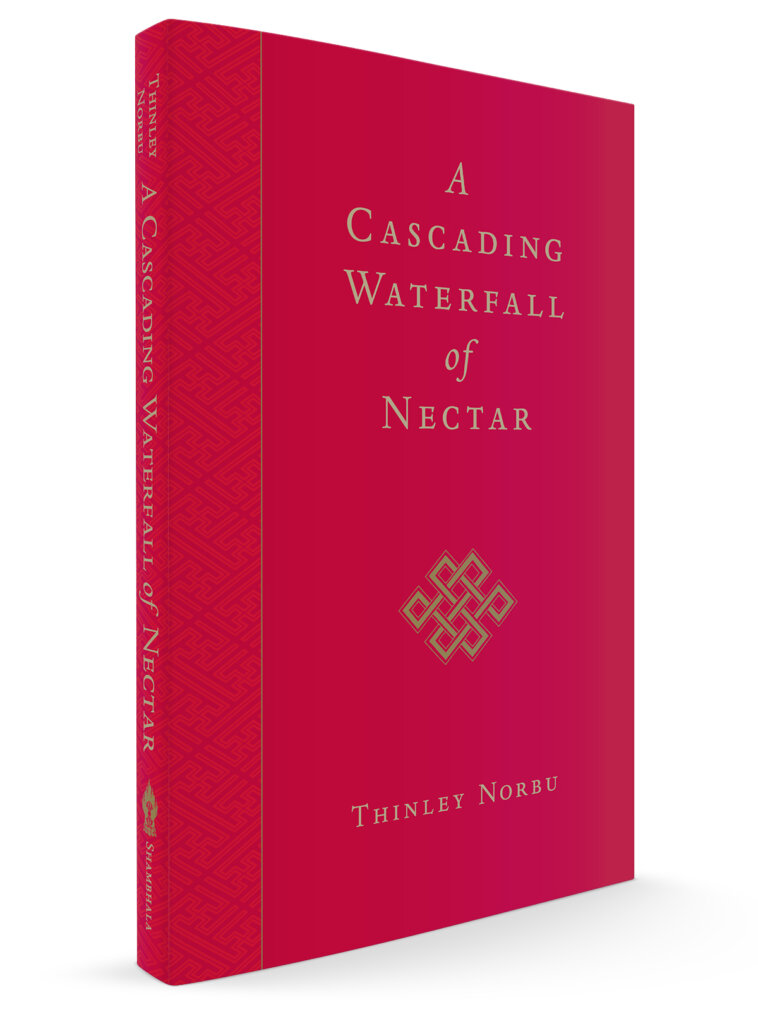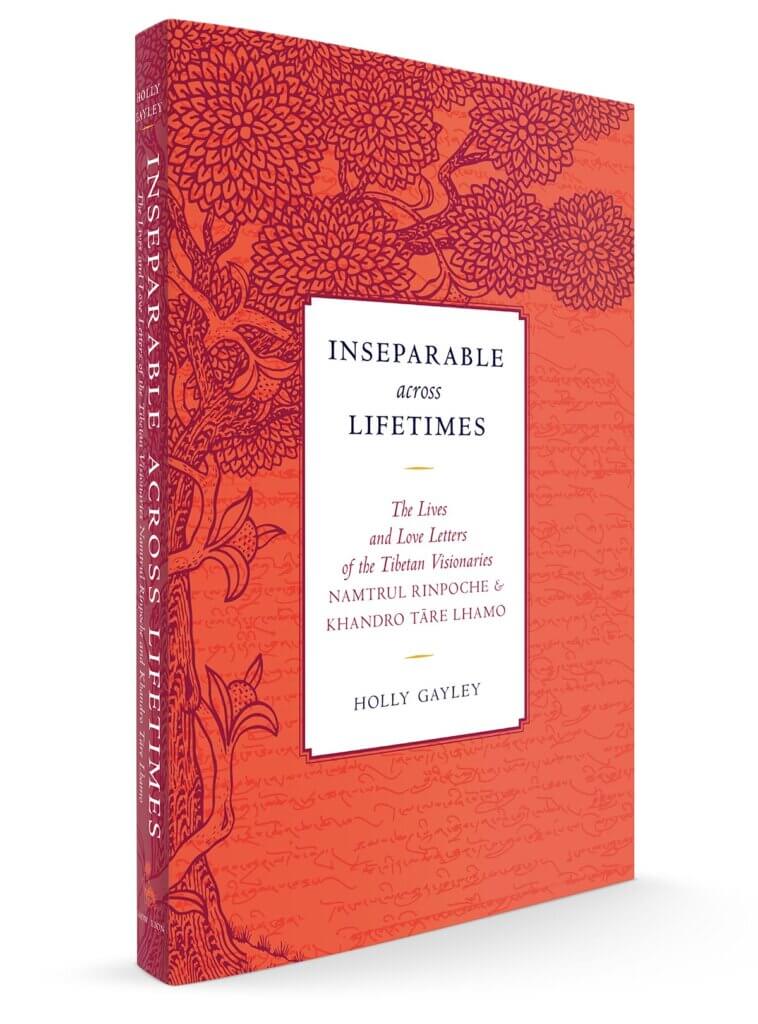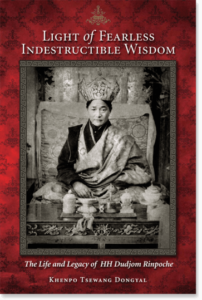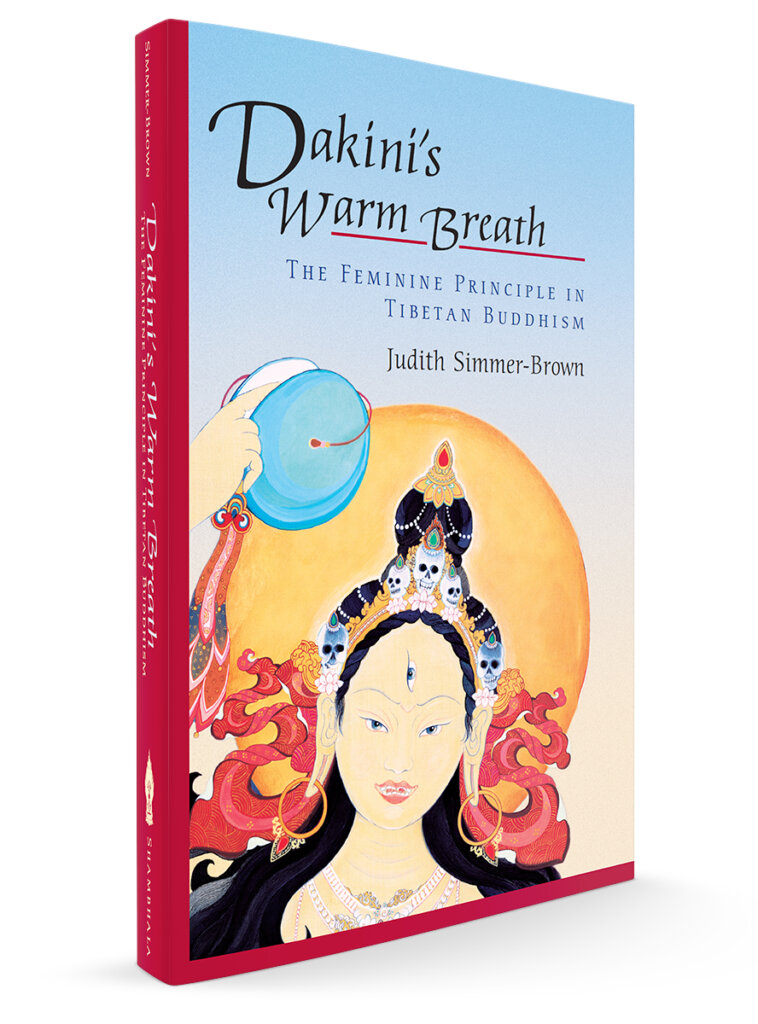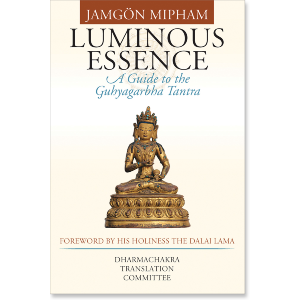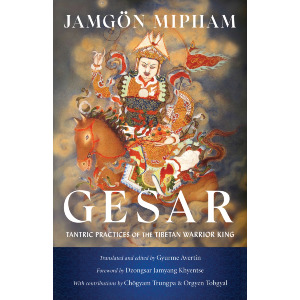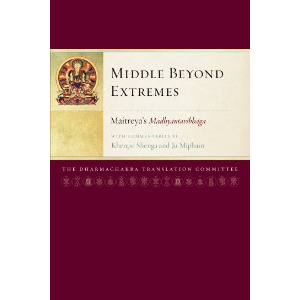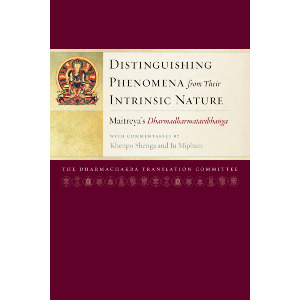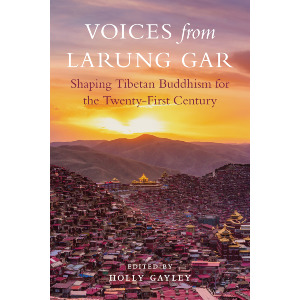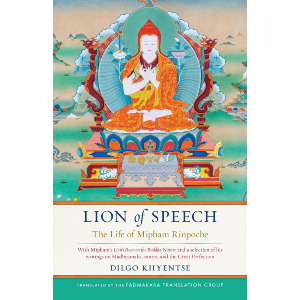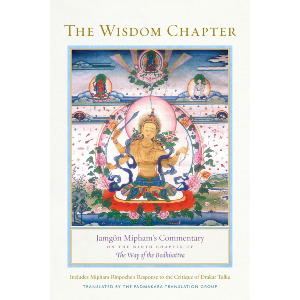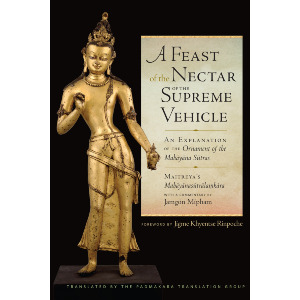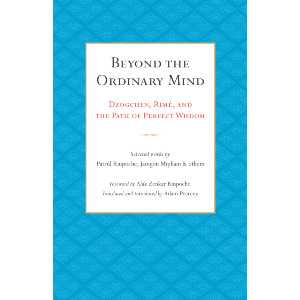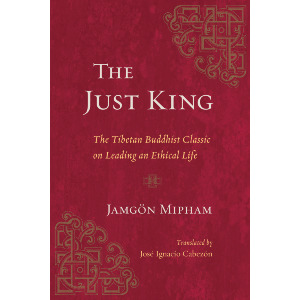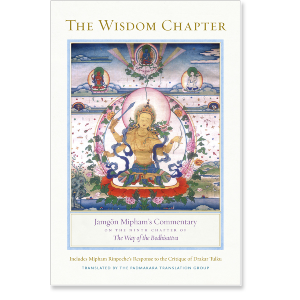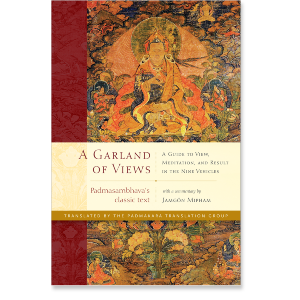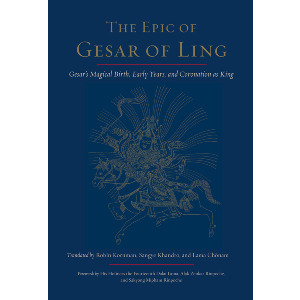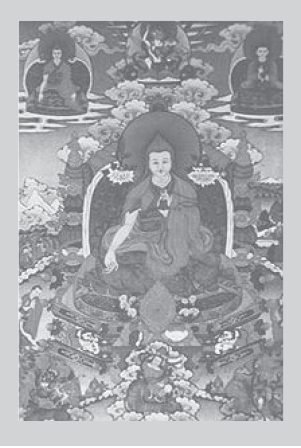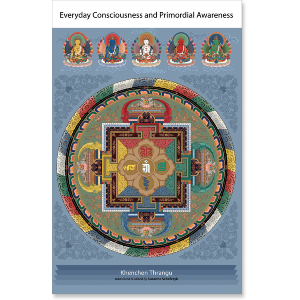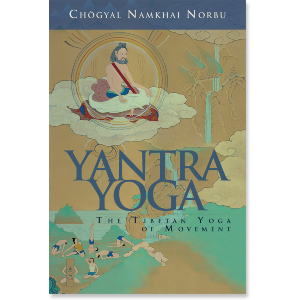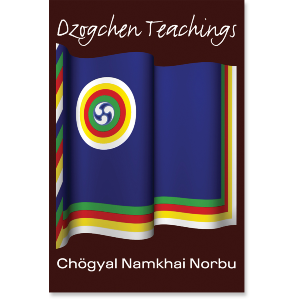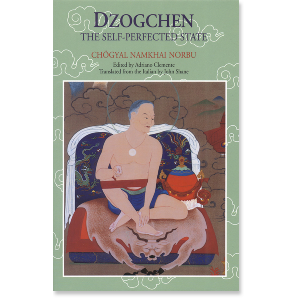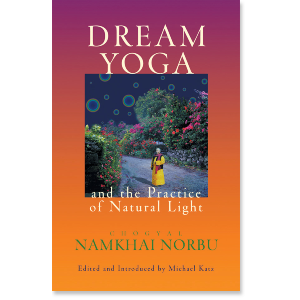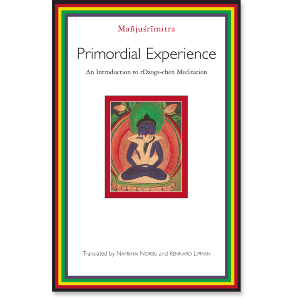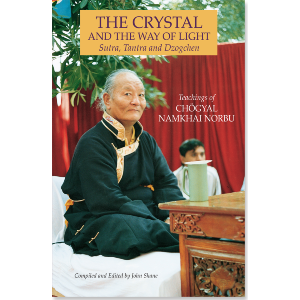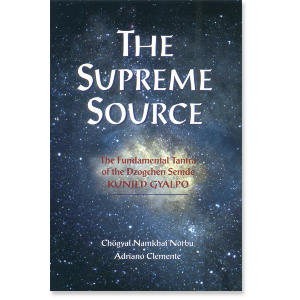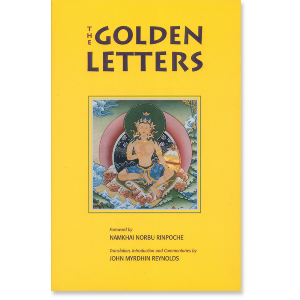See our other Year in Review Guides:
Zen and Chan | Tibetan Buddhism | More in Buddhism
Yoga | Kids Books
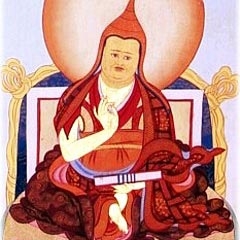

Jamgon Mipham
Jamgon Mipham (1846–1912), one of the great luminaries of Tibetan Buddhism in modern times, has had a dominant and vitalizing influence on the Nyingma School and beyond. He was an important member of the Rimé, or nonsectarian movement, which did much to strengthen and preserve the entire tradition. A scholar of outstanding brilliance and versatility, his translated works are eagerly anticipated by English-language readers.
Jamgon Mipham
-
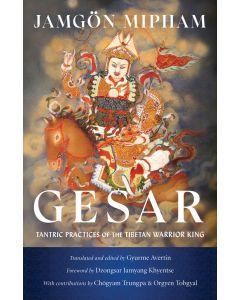 Gesar$29.95- Paperback
Gesar$29.95- PaperbackBy Jamgon Mipham
Foreword by Dzongsar Jamyang Khyentse
Edited by Gyurme Avertin
Translated by Gyurme Avertin
Contributions by Chogyam Trungpa
Contributions by Orgyen Tobgyal -
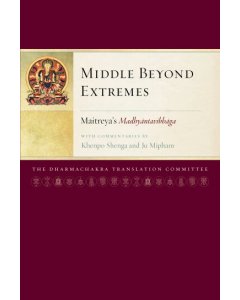 Middle Beyond Extremes$22.95- Paperback
Middle Beyond Extremes$22.95- PaperbackBy Maitreya
By Jamgon Mipham
Translated by Dharmachakra Translation Committee -
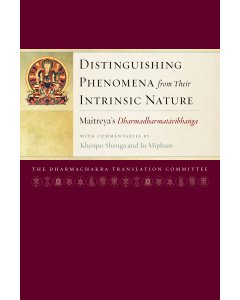 Distinguishing Phenomena from Their Intrinsic Nature$18.95- Paperback
Distinguishing Phenomena from Their Intrinsic Nature$18.95- PaperbackTranslated by Dharmachakra Translation Committee
By Jamgon Mipham
By Maitreya
By Khenpo Shenga -
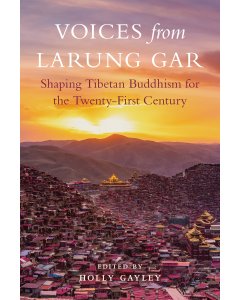 Voices from Larung Gar$24.95- Paperback
Voices from Larung Gar$24.95- PaperbackEdited by Holly Gayley
Contributions by Khenpo Jigme Phuntsok
Contributions by Khenpo Sodargye
Contributions by Khenpo Tsultrim Lodro -
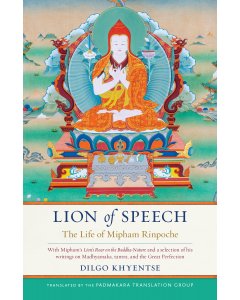 Lion of Speech$27.95- Hardcover
Lion of Speech$27.95- HardcoverTranslated by Padmakara Translation Group
By Dilgo Khyentse
By Jamgon Mipham -
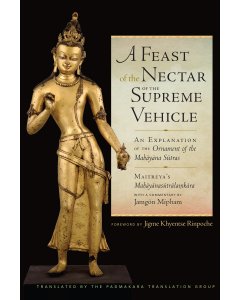 A Feast of the Nectar of the Supreme Vehicle$69.95- Hardcover
A Feast of the Nectar of the Supreme Vehicle$69.95- HardcoverTranslated by Padmakara Translation Group
-
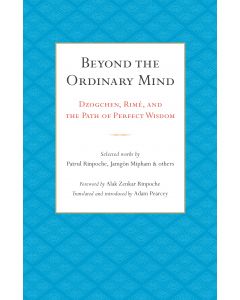 Beyond the Ordinary Mind$24.95- Paperback
Beyond the Ordinary Mind$24.95- PaperbackTranslated by Adam Pearcey
By Patrul Rinpoche
By Jamgon Mipham -
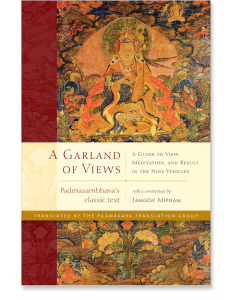 A Garland of Views$22.95- Hardcover
A Garland of Views$22.95- HardcoverBy Padmasambhava
By Jamgon Mipham
Translated by Padmakara Translation Group -
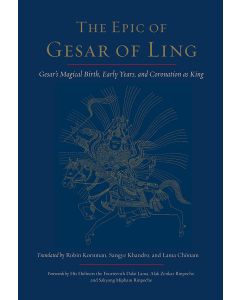 The Epic of Gesar of Ling$49.95- Paperback
The Epic of Gesar of Ling$49.95- PaperbackForeword by H.H. the Fourteenth Dalai Lama
Translated by Robin Kornman
Foreword by Sakyong Mipham Rinpoche
Translated by Lama Chonam
Foreword by Alak Zenkar Rinpoche
Translated by Sangye Khandro
By Jamgon Mipham -
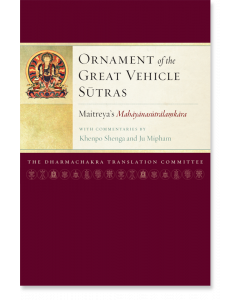 Ornament of the Great Vehicle Sutras$69.95- Hardcover
Ornament of the Great Vehicle Sutras$69.95- HardcoverBy Maitreya
By Jamgon Mipham
Translated by Dharmachakra Translation Committee -
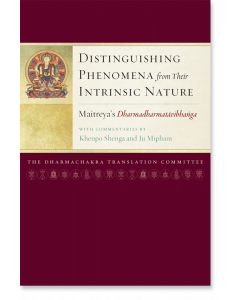 Distinguishing Phenomena from Their Intrinsic Nature$24.95- Hardcover
Distinguishing Phenomena from Their Intrinsic Nature$24.95- HardcoverTranslated by Dharmachakra Translation Committee
By Jamgon Mipham
By Maitreya
By Khenpo Shenga -
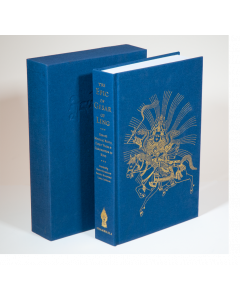 The Epic of Gesar of Ling$120.00- Hardcover
The Epic of Gesar of Ling$120.00- HardcoverTranslated by Robin Kornman
Translated by Lama Chonam
Translated by Sangye Khandro
Foreword by Sakyong Mipham Rinpoche
By Jamgon Mipham
Foreword by Alak Zenkar Rinpoche -
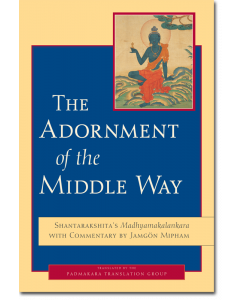 The Adornment of the Middle Way$39.95- Paperback
The Adornment of the Middle Way$39.95- PaperbackTranslated by Padmakara Translation Group
By Jamgon Mipham
By Shantarakshita -
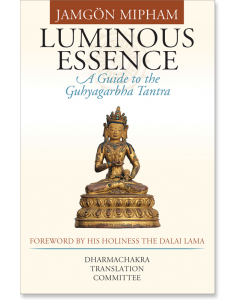 Luminous Essence$34.95- Hardcover
Luminous Essence$34.95- HardcoverBy Jamgon Mipham
Foreword by H.H. the Fourteenth Dalai Lama
Translated by Dharmachakra Translation Committee -
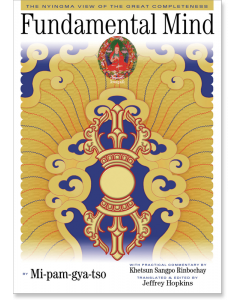 Fundamental Mind$18.95- Paperback
Fundamental Mind$18.95- PaperbackBy Khetsun Sangpo Rinpoche
Edited by Jeffrey Hopkins
Translated by Jeffrey Hopkins
By Jamgon Mipham -
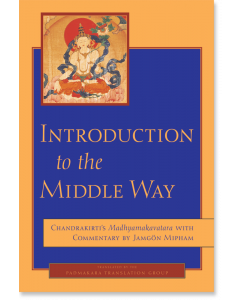 Introduction to the Middle Way$32.95- Paperback
Introduction to the Middle Way$32.95- PaperbackBy Jamgon Mipham
By Chandrakirti
Translated by Padmakara Translation Group -
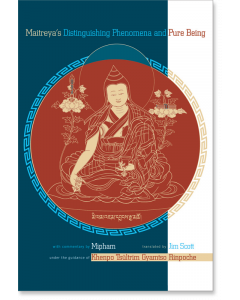 Maitreya's Distinguishing Phenomena and Pure Being$24.95- Paperback
Maitreya's Distinguishing Phenomena and Pure Being$24.95- PaperbackTranslated by Jim Scott
By Jamgon Mipham
Contributions by Jamgon Mipham -
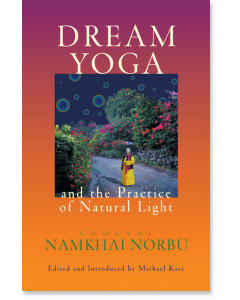 Dream Yoga and the Practice of Natural Light$19.95- Paperback
Dream Yoga and the Practice of Natural Light$19.95- PaperbackBy Chogyal Namkhai Norbu
Edited by Michael Katz
By Jamgon Mipham -
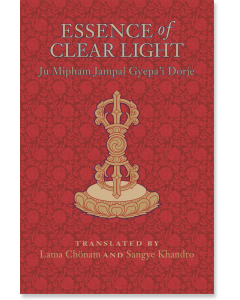 Essence of Clear Light$95.00- Hardcover
Essence of Clear Light$95.00- HardcoverBy Jamgon Mipham
Translated by Lama Chonam
Translated by Sangye Khandro
- Buddhist Academic 9item
- Buddhist Anthology 4item
- Buddhist Art 1 item
- Buddhist Astrology 1 item
- Buddhist Biography/Memoir 3item
- Buddhist Ethics 2item
- Buddhist History 6item
- Buddhist Overviews 3item
- Buddhist Philosophy 16item
- Dependent Origination 4item
- Engaged Buddhism 2item
- Foundation Texts 3item
- Introductions to Buddhism 1 item
- Way of the Bodhisattva 2item
- Women in Buddhism 1 item
- Bodhisattva Path 4item
- Bon Tradition 1 item
- Buddha Nature 2item
- Prajnaparamita 1 item
- Dalai Lamas 3item
- Deity Practice 4item
- Dream Yoga 1 item
- Dzogchen 6item
- Five Maitreya Texts 8item
- Gelug Tradition 4item
- Guru Yoga 1 item
- Kadam Tradition 1 item
- Gesar 4item
- Kagyu Tradition 3item
- Karmapas 3item
- Madhyamaka 10item
- Mahamudra 1 item
- Ngondro 1 item
- Dudjom Tersar 3item
- Longchen Nyingtik 2item
- Nyingma Tradition 26item
- Phowa 2item
- Shambhala Teachings 2item
- Sutra 2item
- Tantra 6item
- Terma / Treasure Texts 2item
- Restricted Texts Requiring Prerequisites 2item
- Tibetan Medicine 1 item
- Tulku Tradition 1 item
- Yogacara 7item
- Women in Buddhism 1 item
- Buddhist Poetry 1 item
- Biography 3item
- Leadership 1 item
GUIDES
Tibetan Buddhist Books in 2023: A Review

Buy 2 books for 20% off, 3 books for 30% off, 4 or more for 35% off.
Applies to physical copies only, Discount applies automatically
We are very happy to share with you a look back at our 2023 books for those who practice in the Tibetan tradition.
Jump to: Reader Guides | Books | Books for Kids | Audiobooks | Forthcoming Books
Remebering Tulku Thondup Rinpoche
The Passing of Christina Monson
Tibetan Masters of the 10th-11th Centuries
Tibetan Masters of the 8th Century
Indian Mahayana Masters of the 2nd-8th Centuries
Naropa: A Reader’s Guide to the Great Master of Mahamudra
Tilopa: A Guide for Readers to the Indian Mahasiddha
Rongzom Mahapandita: A Guide for Readers to Rongzompa
The Guhyagarbha Tantra: A Reader’s Guide to the Glorious Secret Essence
Tangtong Gyalpo: A Guide for Readers
Khenpo Tsültrim Gyamtso: A Guide for Readers
Buddhist Mindfulness: A Guide for Readers
The Works of B. Alan Wallace: A Guide for Readers
Tara the Liberator: A Guide for Readers
A Reader’s Guide to Madhyamaka
Doha and Gur: Indian and Tibetan Songs of Realization
Gyatrul Rinpoche: A Guide for Readers
Paperback | Ebook | Audiobook
$21.95 - Paperback
Awakening Wisdom: Heart Advice on the Fundamental Practices of Vajrayana Buddhism
By Pema Wangyal Rinpoche, translated by Padmakara Translation Group
If you are new to Tibetan Buddhism, this short work will help you get started with your practice; and if you are well steeped in these teachings, it will inspire and motivate you to practice them.
While accessible for beginners, this short volume conveys incredible profundity as well. Originally delivered in the form of advice to retreatants, Pema Wangyal’s teachings cover the practices found across various lineages' foundational practices. But there is a lot more here including the focus on motivation which carries through all the practices; the specifics of posture and somatic breathing; visualization and mantra; mantra of the Budhhas, the mantra of the Prajnaparamita; the practice of Tonglen, and more.
In the last part of the book, he provides guidance about the preliminary practices using as a model those from the Dudjom lineage but applicable for everyone. Pema Wangyal’s writing is suffused with warmth and tenderness throughout, making this book quite accessible and inviting to everyone.
Paperback | Ebook
$29.95 - Paperback
Gesar: Tantric Practices of the Tibetan Warrior King
By Jamgon Mipham
Foreword by Dzongsar Jamyang Khyentse
Edited and translated by Gyurme Avertin
Contributions by Chogyam Trungpa and Orgyen Tobgyal
Gesar of Ling is well known in Tibetan history, literature, and folklore but for Buddhist practitioners he is an enlightened tantric protector and deity, an emanation of Padmasambhava. Engaging in Gesar practice is meant to generate positive circumstances and increase one’s experiences and realization in Buddhist practice.
Three outstanding figures introduce and present this selection of 52 prayers and practices devoted to Gesar compiled by Ju Mipham Rinpoche (1846–1912).
Dzongsar Khyentse cuts through the web of cultural accretions which westerns tend to get caught up in and shows how “Mipham Rinpoche, who had himself invoked the spirit of profound brilliance, recognized that everything about Gesar of Ling had the potential to inspire authentic presence and an appreciation of nowness. And he didn’t think twice about making use of any of it.”
In Chogyam Trungpa’s essay, “Gesar the Warrior” he demonstrates the how Gesar practice embodies the Buddhist notion of warriorship: “Becoming a warrior means that we can look directly at ourselves, see the nature of our cowardly mind, and step out of it. We can trade our small-minded struggle for security for a much vaster vision, one of fearlessness, openness, and genuine heroism”.
And Orgyen Tobgyal, over the course of a disarmingly frank 30 page elucidation of Gesar practice, leaves the reader with a very clear understanding how to approach these practices and understand Gesar.
The forty-five page introduction by the translator gives an overview of all aspects of Gesar and the corpus of texts included in this book.
These practices are meant to be practiced under the guidance of an authentic spiritual teacher. They detail poetic imagery and include guru yoga, praises, invocations, and divinations. Central to all of these practices is raising what is known in Tibetan as lungta, or “windhorse,” a dignified energy that propels and enhances one’s wisdom, compassion, and power to benefit all beings.
Paperback | Ebook
$21.95 - Paperback
By Andy Karr, foreword by Matthieu Ricard
Into the Mirror is a call to cultivate wisdom and compassion—right within this world of illusion—and an insightful challenge to the rampant materialism of modernity. Andy Karr presents accessible and powerful methods to accomplish this through investigating the way our minds construct our worlds.
Combining contemporary Western inquiries with classical Buddhist investigations into the nature of mind, Karr invites the reader to make a personal, experiential journey through study, contemplation, and meditation. He presents a series of contemplative practices from Mahayana Buddhism, starting with the Middle Way teachings on emptiness and interdependence, through Yogachara’s subtle understanding of nonduality, to the view that buddha nature is already within us to be revealed rather than something external to be acquired.
Hardcover | Ebook
$39.95 - Hardcover
Sakya: The Path with Its Result, Part Twp: Essential Teachings of the Eight Practice Lineages of Tibet, Volume 6
By Jamgon Kongtrul Lodro Taye
Translated by Malcolm Smith
The sixth volume of this series, and part two of Sakya: The Path with Its Result, completes Kongtrul’s presentation of a selection of texts from the Sakya tradition of Tibetan Buddhism. This volume includes the complete teachings and practices of the Eight Ancillary Path Cycles. These eight complete the nine path cycles that begin with Virūpa’s Vajra Verses found in volume five of the series. These path cycles are generally only taught to students who have received the entire Path with Its Result (Lamdre) teaching. They contain oral instructions transmitted to Drokmi Lotsāwa by the early eleventh-century Indian masters—Ācārya Vīravajra, Mahāsiddha Amoghavajra, Pandita Prajñāgupta of Oddiyāna, and Pandita Gayadhara. These cycles provide copious material on the creation and completion stages, which was incorporated later into the Three Tantras literature, the signature Vajrayāna teaching of the Sakya school.
Hardcover | Ebook
$49.95 - Hardcover
Shangpa Kagyu: The Tradition of Khyungpo Naljor, Part Two: Essential Teachings of the Eight Practice Lineages of Tibet, Volume 12
By Jamgon Kongtrul Lodro Taye
Translated by Sarah Harding
This is the second of two volumes that present teachings and practices from the Shangpa Kagyu practice lineage of Tibetan Buddhism. This tradition derives from two Indian yoginīs, the dākinīs Niguma and Sukhasiddhi, and their disciple, the eleventh-century Tibetan yogi Khyungpo Naljor Tsultrim Gönpo of the Shang region of Tibet. There are forty texts in this volume, beginning with Jonang Tāranātha’s classic commentary and its supplement expounding the Six Dharmas of Niguma. It includes the definitive collection of the tantric bases of the Shangpa Kagyu—the five principal deities of the new translation (sarma) traditions and the Five-Deity Cakrasamvara practice. The source scriptures, liturgies, supplications, empowerment texts, instructions, and practice manuals were composed by Tangtong Gyalpo, Tāranātha, Jamgön Kongtrul, and others.
Hardcover | Ebook
$49.95 - Hardcover
Marpa Kagyu, Part One: Methods of Liberation: Essential Teachings of the Eight Practice Lineages of Tibet, Volume 7
By Jamgon Kongtrul Lodro Taye
Translated by Elizabeth Callahan
Mahāsiddha Practice, the sixteenth volume, presents a selection of teachings and practices centered on the mahāsiddhas, Indian tantric masters. The mahāsiddha Mitrayogin, whose work forms the majority of this volume, visited Tibet in the late twelfth century. His ritual texts along with instructions are here translated from Tibetan, including sādhanas, empowerments, guru yogas, authorization rituals for protector deities, and detailed compositions on Mahāmudrā practice, or resting in the nature of mind. In addition to instructions given by mahāsiddhas, this volume includes ritual practices to visualize them and transmit their blessings, beginning with a devotional text composed by Jamgön Kongtrul himself.
Paperback | Ebook
$22.95 - Paperback
Embodying Tara: Twenty-One Manifestations to Awaken Your Innate Wisdom
By Chandra Easton
Tara, the Buddhist goddess of compassion, can manifest within all of us. In this illustrated introduction to Tara's twenty-one forms, respected female Buddhist teacher and practitioner Dorje Lopön Chandra Easton shows you how to invite Tara’s awakened energy to come alive in yourself through:
- insight into core Buddhist concepts and teachings;
- meditations;
- mantra recitations; and
- journal exercises.
The relatable stories from Buddhist history and the author’s personal reflections will give you the tools to live a more compassionate life, befriend your fears, and overcome everyday challenges.
Find out how important women and movements in modern history have achieved this through their own embodiment of Tara's enlightened activities. The stories of Jane Goodall, Nawal El Saadawi, Oprah Winfrey, Vandana Shiva, Black Lives Matter, Me Too, and others will inspire you to bring these aspects of Tara into the world in creative and socially conscious ways for the benefit of all.
Rebirths: New Editions of Classics
Paperback | Ebook
$34.95 - Paperback
Wisdom Nectar: Dudjom Rinpoche's Heart Advice
By Dudjom Rinpoche, foreword by Lama Tharchin Rinpoche
Dudjom Rinpoché was one of the most important figures in Tibetan Buddhism in the twentieth century, yet very few of his religious writings have been translated into English. This volume contains a generous selection of his monumental teachings and writings, the core of which is a lengthy discussion of the entire path of Dzogchen, including key instructions on view, meditation, and conduct, along with direct advice on how to bring one’s experiences onto the path.
Also included in this book in their entirety are the oral instructions, tantric songs, and songs of realization from His Holiness’s Collected Works, along with selections from his aspiration and supplication prayers.
Paperback | Ebook
$39.95 - Paperback
The Autobiography of Jamgon Kongtrul: A Gem of Many Colors
By Jamgon Kongtrul Lodro Taye
Translated by Richard Barron (Chokyi Nyima)
This extraordinary account of the life of Tibet’s Leonardo da Vinci provides, in his own words, an illuminating glimpse into the religion, culture, and politics of nineteenth-century Tibet.
Jamgön Kongtrul Lodrö Thayé (1813–1899) was one of the most influential figures and prolific writers in the Tibetan Buddhist world. He was a founder and the single most important proponent of the nonsectarian Rimé movement that flourished in eastern Tibet and remains popular today.
This volume includes the first English translation of Kongtrul’s autobiography, A Gem of Many Colors, and two additional texts. The first, written by one of Kongtrul’s close personal students, discusses Kongtrul’s final days, his funeral, and the commemorative rites following his death. The second, authored by Kongtrul himself, recounts his past lives. Taken together, these three texts place Kongtrul firmly in his historical context as one of the most important Buddhist masters to ever hail from Tibet.
Paperback | Ebook
$21.95 - Paperback
Reflections on a Mountain Lake: Teachings on Practical Buddhism
By Jetsunma Tenzin Palmo
An inspiring, practical guide to walking the spiritual path with wisdom and ease—from one of the foremost living Buddhist nuns.
This broad-ranging collection of Dharma teachings by Jetsunma Tenzin Palmo addresses topics of common concern to Buddhist practitioners from all traditions—including the particular challenges facing Western practitioners, what to expect of a teacher-student relationship, gender issues and the role of women, how to approach meditation practice, and much more. Personable, witty, and profound, Tenzin Palmo presents an inspiring and no-nonsense view of Buddhist practice that comes from a heart infused with wisdom and compassion.
New in Paperback
Hardcover | Ebook | Audiobook
$21.95 - Paperback
How We Live Is How We Die
By Pema Chodron
In How We Live Is How We Die, Pema Chödrön shares her wisdom for working with this flow of life—learning to live with ease, joy, and compassion through uncertainty, embracing new beginnings, and ultimately preparing for death with curiosity and openness rather than fear.
Poignant for readers of all ages, her teachings on the bardos—a Tibetan term referring to a state of transition, including what happens between this life and the next—reveal their power and relevance at each moment of our lives. She also offers practical methods for transforming life’s most challenging emotions about change and uncertainty into a path of awakening and love. As she teaches, the more freedom we can find in our hearts and minds as we live this life, the more fearlessly we’ll be able to confront death and what lies beyond. In all, Pema provides readers with a master course in living life fully and compassionately in the shadow of death and change.
Hardcover | Ebook
$21.95 - Hardcover
The Magical Life of the Lotus-Born
By Sherab Kohn
Explore a fresh telling of the inspiring, mysterious, and magical life of the great master Padmasambhava—the Lotus-Born—who planted the seed of Buddhism in Tibet that is still blossoming today, beautifully illustrated for ages 10+.
The Lotus-Born is one of the most iconic and important figures in Tibetan history. Here, his magical life story is outlined in colorful and captivating detail, offering young readers a rare glimpse into his fierce adventures and battles that transformed Tibet, a land of malevolent spirits and wild folk, into a fertile ground for Buddhism. The rich and vibrant spiritual tradition that resulted in Tibet has thrived for over one thousand years. This timeless tale is sure to capture the imagination of future generations, just as the oral, theatrical, and written accounts of it have in the Himalayas for centuries.
Forthcoming in 2024
And we have even more from the Tibetan tradition coming out next year from the likes of Sera Khandro, Khenpo Sodargye, Khangsar Tenpe Wangchuk, Jamgon Kongtrul, Khenpo Sherab Sangpo, Gaylon Ferguson, Jigme Wangdrak, Orgyen Chowang, Thubten Chodron, Dza Kilung, Cortland Dahl, Dzigar Kongtul, Tina Draszczyk, and more. So make sure you sign up for our emails so you do not miss them! Here is a sneak peek at our first 2024 release which you can pre-order now and take advantage of the discount.
Tibetan Buddhism: A Guide to Contemplation, Meditation, and Transforming Your Mind
By Khenpo Sodargye
Your genuine, go-to overview of Tibetan Buddhism from a leading contemporary teacher who has traversed the wisdom path.
This guide shares Tibetan Buddhist insight and tools that will benefit everyone in transforming their mind. Khenpo Sodargye, who has attracted hundreds of thousands of students worldwide with his concise, easy-to-follow teaching style, sketches the big picture of the Mahayana path in straightforward language with stories relevant to everyday life. He draws on authentic texts and teachings by renowned Buddhist masters to explain complex concepts like:
- The Four Dharma Seals
- Faith
- Bodhicitta
- The Three Supreme Methods
- The Two Truths
- Rebirth and karma
- Spiritual teachers
- The Great Perfection
This book introduces a systematic approach to studying Buddhism. Through proper listening, contemplating, and meditating, we can generate the wisdom that enables us to recognize, control, and uproot our afflictions, which is the essence of Buddhism. This book is the perfect companion for anyone wanting to learn more about the basics of Mahayana Buddhism or to strengthen the foundations of their spiritual practice.
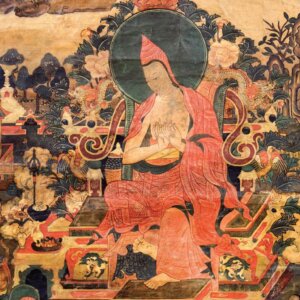
Asanga and Yogacara: A Guide for Readers

Asanga
Asanga and Yogacara: A Guide for Readers
Asanga, from The Buddhist Art Coloring Book
Asanga, along with his brother Vasabandu, is an inestimably important figure in Mahayana Buddhism, associated with some of the most important works on ethical and moral dimensions of progress on the path, as well as the Yogacara philosophical school. He is particularly revered in Tibet and East Asia.
Asanga is best known for his two "Summary Treatises" and the teachings he received from Maitreya, the Five Maitreya texts.
The following is from Indestructible Truth: The Living Spirituality of Tibetan Buddhism:
Asanga, considered the founder of the Yogachara school, was born into a Buddhist family in the region of Gandhara in northwestern India.3 As a child, he was drawn strongly to meditation but was also schooled in the major divisions of learning then current in India, including writing, debate, mathematics, medicine, and the fine arts. Asanga was a brilliant student and excelled at whatever he tried. At an early age, he took Buddhist ordination within a Hinayana sect, the Mahishasaka, known for the great importance it attached to the practice of meditation.
Asanga trained under several teachers, mastering the Hinayana scriptures and studying Mahayana sutras. When he encountered the Prajnaparamita sutras, however, he found that while he could read their words, he did not really understand their inner meaning or the awakening they described. Asanga felt compelled by these teachings and recognized that the only way he could gain the transcendent wisdom that he longed for would be to enter into a meditation retreat. Having received instruction from his guru, he now went into strict retreat on Mount Kukkutapada. He spent his time meditating and supplicating his personal deity, the future buddha, Maitreya, for guidance, inspiration, and teaching.
Essential Texts by Asanga
Three Volume Slipcase | Ebook
$150.00 - Hardcover
A Compendium of the Mahayana: Asanga’s Mahayanasamgraha and Its Indian and Tibetan Commentaries
By Karl Brunnholzl
Asanga's The Compendium of the Mahayana, or Mahāyānasaṃgraha, is one of the greatest works expounding the Yogacara teachings of Mahayana. It is also an incrediblefeat of translation, done by master translator and scholar Karl Brunnholzl.
The Mahāyānasaṃgraha, published here with its Indian and Tibetan commentaries in three volumes, presents virtually everything anybody might want to know about the Yogācāra School of Mahāyāna Buddhism. It discusses in detail the nature and operation of the eight kinds of consciousness, the often-misunderstood notion of “mind only” (cittamātra), dependent origination, the cultivation of the path and its fruition in terms of the four wisdoms, and the three bodies (kāyas) of a buddha.
Volume 1 presents the translation of the Mahāyānasaṃgraha along with a commentary by Vasubandhu. The introduction gives an overview of the text and its Indian and Tibetan commentaries, and explains in detail two crucial elements of the Yogācāra view: the ālaya-consciousness and the afflicted mind (klistamanas).
Volume 2 presents translations of the commentary by Asvabhāva and an anonymous Indian commentary on the first chapter of the text. These translations are supplemented in the endnotes by excerpts from Tibetan commentaries and related passages in other Indian and Chinese Yogācāra works.
Volume 3 includes appendices with excerpts from other Indian and Chinese Yogācāra texts and supplementary materials on major Yogācāra topics in the Mahāyānasaṃgraha.
Hardcover | Ebook
$59.95 - Hardcover
The Bodhisattva Path to Unsurpassed Enlightenment: A Complete Translation of the Bodhisattvabhumi
By Asanga, translated by Artemus Engle
Ārya Asanga’s Bodhisattvabhūmi, or The Stage of a Bodhisattva, is the Mahāyāna tradition’s most comprehensive manual on the practice and training of bodhisattvas—by the author’s own account, a compilation of the full range of instructions contained in the entire collection of Mahāyāna sutras. A classic work of the Yogācāra school, it has been cherished in Tibet by all the historical Buddhist lineages as a primary source of instruction on bodhisattva ethics, vows, and practices, as well as for its summary of the ultimate goal of the bodhisattva path—supreme enlightenment.
Despite the text’s seminal importance in the Tibetan traditions, it long remained unavailable in English except in fragments. Engle’s translation, made from the Sanskrit original with reference to the Tibetan translation and commentaries, will enable English readers to understand more fully and clearly what it means to be a bodhisattva and practitioner of the Mahāyāna tradition.
A Deep Dive on the Bodhisattvabhumi
Once you have a copy of The Bodhisattva Path to Unsurpassed Enlightenment, a great complement to reading the book is to watch translator and scholar Artemus Engle discuss the work in detail, offering great context. Watch the preview here for a taste, and then jump right into the two talks, free to all.
Overview and Trailer
Part I, 1.5 Hours
Part II, 2 Hours
The Five Maitreya Texts
See also our two interviews on these texts with Karl Brunnholzl and Thomas Doctor of the Dharmachakra Translation Committee.
In Peaceful Heart, Dzigar Kongtrul Rinpoche recounts the story of how Asanga met Maitreya and received the teachings that come down to us as The Five Maitreya texts:
Asanga isolated himself in strict retreat, devoting all his time to practices related to Maitreya. His hope was for Maitreya to appear before him and give him instructions that would lead him to enlightenment. But after six years of diligent practice with no results, Asanga got frustrated and left. On his way home, he met a man who was rubbing a large iron bar with a soft piece of cloth. When Asanga asked what he was doing, the man said he was making a needle. Amazed at the effort people go through to accomplish futile aims, Asanga realized he needed to be more persistent on his path to enlightenment. So he returned to his retreat, determined never to give up. But three years later, when Maitreya still hadn’t appeared, not even in a dream, Asanga again left. This time he met a man who was stroking a massive boulder with a feather dipped in water. The man told him that he wanted to wear away the boulder because it was blocking the sunlight from his house. This gave Asanga renewed determination to keep persevering with his practice. But still Maitreya didn’t come.
Another uneventful and discouraging three years passed. Finally, Asanga left again and began to wander around, feeling hopeless and lost. He saw a crippled dog dragging herself along the road. Her rotting body was infested with maggots that were eating her flesh. Full of pain and aggression, the dog barked viciously at Asanga when he came closer. The sight broke Asanga’s heart. He thought about how to remove the maggots. If he used his hands, the maggots would probably be crushed, so the only way was to use his tongue. Disgusted by the rotting flesh, Asanga closed his eyes and stretched out to lick the maggots out of the dog. But as far as he stretched, he still didn’t feel the maggots. Finally, he felt his tongue touch the ground. He opened his eyes. Instead of the dog, Maitreya stood before him.
"How little compassion you have!" Asanga burst out. "I practiced for twelve years, and you didn’t even appear in my dreams!” Maitreya said, “Since the very first day of your retreat, I’ve been right there with you, but you didn’t have the openness to see me. Your twelve years of practice made your obscurations thinner. Today, your pure compassion for this dog finally made you open enough to see me in person. If you don’t believe me, put me on your shoulder and walk around.” Asanga put Maitreya on his shoulder and walked around at a fair, asking people what they saw on his shoulder. No one saw anything. They just thought he was crazy. Finally, an old woman, who also had developed enough openness to have higher perceptions, asked, “Why are you carrying a rotten dog on your shoulder?"
From then on, Maitreya imparted the teachings which we now know as The Five Maitreya Texts.
The Ornament of Clear Realization: The Abhisamayālaṃkāra
The Abhisamayalamkara summarizes all the topics in the vast body of the Prajnaparamita Sutras. Resembling a zip-file, it comes to life only through its Indian and Tibetan commentaries. Together, these texts not only discuss the "hidden meaning" of the Prajnaparamita Sutras—the paths and bhumis of sravakas, pratyekabuddhas, and bodhisattvas—but also serve as contemplative manuals for the explicit topic of these sutras—emptiness—and how it is to be understood on the progressive levels of realization of bodhisattvas. Thus these texts describe what happens in the mind of a bodhisattva who meditates on emptiness, making it a living experience from the beginner's stage up through buddhahood.
The Ornament of Clear Realization
Karl Brunnholzl discussing the two Gone Beyond volumes on the Kagyu tradition and the Ornament of Clear Realization and Groundless Paths which is the Nyingma take on the same work
Hardcover | Ebook
$54.95 - Hardcover
Gone Beyond (Volume 1)
The Prajnaparamita Sutras, The Ornament of Clear Realization, and Its Commentaries in the Tibetan Kagyu Tradition
By Asanga, Maitreya, the Fifth Shamar Rinpoche, and Karl Brunnholzl
Gone Beyond contains the first in-depth study of the Abhisamayalamkara (the text studied most extensively in higher Tibetan Buddhist education) and its commentaries in the Kagyu School. This study (in two volumes) includes translations of Maitreya's famous text and its commentary by the Fifth Shamarpa Goncho Yenla (the first translation ever of a complete commentary on the Abhisamayalamkara into English), which are supplemented by extensive excerpts from the commentaries by the Third, Seventh, and Eighth Karmapas and others. Thus it closes a long-standing gap in the modern scholarship on the Prajnaparamita Sutras and the literature on paths and bhumis in mahayana Buddhism.
The first volume presents an English translation of the first three chapters of the Abhisamayalamkara and its commentary by the Fifth Shamarpa.
Hardcover | Ebook
$44.95 - Hardcover
Gone Beyond (Volume 2)
The Prajnaparamita Sutras, The Ornament of Clear Realization, and Its Commentaries in the Tibetan Kagyu Tradition
By Asanga, Maitreya, the Fifth Shamar Rinpoche, and Karl Brunnholzl
The second volume presents an English translation of the final five chapters and their commentary by the Fifth Shamarpa.
Hardcover | Ebook
$54.95 - Hardcover
Groundless Paths: The Prajnaparamita Sutras, The Ornament of Clear Realization, and Its Commentaries in the Tibetan Nyingma Tradition
By Asanga, Maitreya, Patrul Rinpoche, Mipham Rinpoche, and Karl Brunnholzl
This study consists mainly of translations of Maitreya's famous text and two commentaries on it by Patrul Rinpoche. These are supplemented by three short texts on the paths and bhumis by the same author, as well as extensive excerpts from commentaries by six other Nyingma masters, including Mipham Rinpoche. Thus this book helps close a long-standing gap in the modern scholarship on the prajñaparamita sutras and the literature on paths and bhumis in mahayana Buddhism.
The Ornament of Mahayana Sutras: The Māhayānasūtrālaṃkāra
Padmakara's Stephen Gethin on the Mahāyānasūtrālaṃkāra
A discussion of the Feast of the Nectar of the Supreme Vehicle and the importance of Mipham Rinpoche's commentary.
Hardcover | Ebook
$54.95 - Hardcover
A Feast of the Nectar of the Supreme Vehicle: An Explanation of the Ornament of the Mahayana Sutras
By Asanga, Mipham Rinpoche. Translated and introduced by the Padmakara Translations Group
A monumental work and Indian Buddhist classic, the Ornament of the Mahāyāna Sūtras (Mahāyānasūtrālamkāra) is a precious resource for students wishing to study in-depth the philosophy and path of Mahāyāna Buddhism. This full translation and commentary outlines the importance of Mahāyāna, the centrality of bodhicitta or the mind of awakening, the path of becoming a bodhisattva, and how one can save beings from suffering through skillful means.
This definitive composition of Mahāyāna teachings was imparted in the fourth century by Maitreya to the famous adept Asanga, one of the most prolific writers of Buddhist treatises in history. Asanga’s work, which is among the famous Five Treatises of Maitreya, has been studied, commented upon, and taught by Buddhists throughout Asia ever since it was composed.
In the early twentieth century, one of Tibet’s greatest scholars and saints, Jamgön Mipham, wrote A Feast of the Nectar of the Supreme Vehicle, which is a detailed explanation of every verse. This commentary has since been used as the primary blueprint for Tibetan Buddhists to illuminate the depth and brilliance of Maitreya’s pith teachings. The Padmakara Translation Group has provided yet another accessible and eloquent translation, ensuring that English-speaking students of Mahāyāna will be able to study this foundational Buddhist text for generations to come.
Distinguishing the Middle from Extremes: The Madhyāntavibhāga
This text explains the vast paths of all three yanas, emphasizing the view of Yogācāra (including the Yogācāra Middle Way) and the distinctive features of the mahāyāna.
Paperback | Ebook
$22.95 - Paperback
Middle Beyond Extremes: Maitreya's Madhyantavibhaga with Commentaries by Khenpo Shenga and Ju Mipham
By Asanga, Khenpo Shenga, Mipham Rinpoche. Translated and introduced by the Padmakara Translations Group
This text employs the principle of the three natures to explain the way things seem to be as well as the way they actually are. It is presented here alongside commentaries by two outstanding masters of Tibet’s nonsectarian Rimé movement, Khenpo Shenga and Ju Mipham.
Distinguishing Phenomena from Their Intrinsic Nature : The Dharmadharmatāvibhāga
This text discusses the difference between samsaric confusion and the liberating power of nonconceptual wisdom-the heart essence of all profound sutras.
Paperback | Ebook
$18.95 - Paperback
Distinguishing Phenomena from Their Intrinsic Nature: Maitreya's Dharmadharmatavibhanga with Commentaries by Khenpo Shenga and Ju Mipham
By Asanga, Maitreya, Khenpo Shenga, Mipham Rinpoche. Translated and introduced by the Dharmachakra Translation Committee
Outlining the difference between appearance and reality, this work shows that the path to awakening involves leaving behind the inaccurate and limiting beliefs we have about ourselves and the world around us and opening ourselves to the limitless potential of our true nature.
By divesting the mind of confusion, the treatise explains, we see things as they actually are. This insight allows for the natural unfolding of compassion and wisdom. This volume includes commentaries by Khenpo Shenga and Ju Mipham, whose discussions illuminate the subtleties of the root text and provide valuable insight into the nature of reality and the process of awakening.
Paperback | Ebook
$24.95 - Paperback
Adorning Maitreya’s Intent: Arriving at the View of Nonduality
By Asanga, Maitreya, Rongtonpa, introduced and translated by Christian Bernert
Here, the Tibetan master Rongtön unpacks this manual and its practices for us in a way that is at once accessible and profound, with actual practical meditative applications. The work explains the vast paths of the three vehicles of Buddhism, emphasizing the view of Yogācāra, and demonstrates the inseparability of experience and emptiness. It offers a detailed presentation of the three natures of reality, an accurate understanding of which provides the antidotes to confusion and suffering. The translator’s introduction presents a clear overview of all the concepts explored in the text, making it easy for the reader to bridge its ideas to actual practice.
Hardcover | Ebook
$39.95 - Hardcover
Mining for Wisdom within Delusion: Maitreya's Distinction between Phenomena and the Nature of Phenomena and Its Indian and Tibetan Commentaries
By Asanga, Maitreya, Vasabandhu, Gö Lotsāwa, The Third Karmapa Rangjung Dorje, . Translated and introduced by Karl Brunnholzl.
Maitreya’s Distinction between Phenomena and the Nature of Phenomena distinguishes the illusory phenomenal world of saṃsāra produced by the confused dualistic mind from the ultimate reality that is mind’s true nature. The transition from the one to the other is the process of “mining for wisdom within delusion.” Maitreya’s text calls this “the fundamental change,” which refers to the vanishing of delusive appearances through practicing the path, thus revealing the underlying changeless nature of these appearances. In this context, the main part of the text consists of the most detailed explanation of nonconceptual wisdom—the primary driving force of the path as well as its ultimate result—in Buddhist literature.
The introduction of the book discusses these two topics (fundamental change and nonconceptual wisdom) at length and shows how they are treated in a number of other Buddhist scriptures. The three translated commentaries, by Vasubandhu, the Third Karmapa, Rangjung Dorje, and Gö Lotsāwa, as well as excerpts from all other available commentaries on Maitreya’s text, put it in the larger context of the Indian Yogācāra School and further clarify its main themes. They also show how this text is not a mere scholarly document, but an essential foundation for practicing both the sūtrayāna and the vajrayāna and thus making what it describes a living experience. The book also discusses the remaining four of the five works of Maitreya, their transmission from India to Tibet, and various views about them in the Tibetan tradition.
Paperback | Ebook
$24.95 - Paperback
Maitreya's Distinguishing Phenomena and Pure Being
By Asanga, Maitreya, and Mipham Rinpoche. Translated by Jim Scott under the guidance of Khenpo Tsultrim Gyamtso.
Maitreya’s Distinction between Phenomena and the Nature of Phenomena distinguishes the illusory phenomenal world of saṃsāra produced by the confused dualistic mind from the ultimate reality that is mind’s true nature. The transition from the one to the other is the process of “mining for wisdom within delusion.” Maitreya’s text calls this “the fundamental change,” which refers to the vanishing of delusive appearances through practicing the path, thus revealing the underlying changeless nature of these appearances. In this context, the main part of the text consists of the most detailed explanation of nonconceptual wisdom—the primary driving force of the path as well as its ultimate result—in Buddhist literature.
The introduction of the book discusses these two topics (fundamental change and nonconceptual wisdom) at length and shows how they are treated in a number of other Buddhist scriptures. The three translated commentaries, by Vasubandhu, the Third Karmapa, Rangjung Dorje, and Gö Lotsāwa, as well as excerpts from all other available commentaries on Maitreya’s text, put it in the larger context of the Indian Yogācāra School and further clarify its main themes. They also show how this text is not a mere scholarly document, but an essential foundation for practicing both the sūtrayāna and the vajrayāna and thus making what it describes a living experience. The book also discusses the remaining four of the five works of Maitreya, their transmission from India to Tibet, and various views about them in the Tibetan tradition.
The Sublime Continuum: The Uttaratantra Śāstra
Also known as the Ratnagotravibhāga Mahāyānottaratantraśāstra, this is a general commentary on buddha nature and represents a bridge between sutra and tantra.
Hardcover | Ebook
$49.95 - Hardcover
When the Clouds Part: The Uttaratantra and Its Meditative Tradition as a Bridge between Sutra and Tantra
By Asanga, Karl Brunnholzl, Mipham Rinpoche, Pema Karpo, Mönlam Tsültrim, Eighth Karmapa, Jamgon Kongtrul and more.
This book discusses a wide range of topics connected with the notion of buddha nature as presented in Indo-Tibetan Buddhism and includes an overview of the sūtra sources of the tathāgatagarbha teachings and the different ways of explaining the meaning of this term. It includes new translations of the Maitreya treatise Mahāyānottaratantra (Ratnagotravibhāga), the primary Indian text on the subject, its Indian commentaries, and two (hitherto untranslated) commentaries from the Tibetan Kagyü tradition. Most important, the translator’s introduction investigates in detail the meditative tradition of using the Mahāyānottaratantra as a basis for Mahāmudrā instructions and the Shentong approach. This is supplemented by translations of a number of short Tibetan meditation manuals from the Kadampa, Kagyü, and Jonang schools that use the Mahāyānottaratantra as a work to contemplate and realize one’s own buddha nature.
Paperback | Ebook
$34.95 - Paperback
Buddha Nature: The Mahayana Uttaratantra Shastra with Commentary
By Maitreya, Asanga, Jamgon Kongtrul, Khenpo Tsultrim Gyamtso, translated by Rosemarie Fuchs
All sentient beings, without exception, have buddha nature—the inherent purity and perfection of the mind, untouched by changing mental states. Thus there is neither any reason for conceit nor self-contempt. This is obscured by veils that are removable and do not touch the inherent purity and perfection of the nature of the mind. The Mahayana Uttaratantra Shastra, one of the “Five Treatises” said to have been dictated to Asanga by the Bodhisattva Maitreya, presents the Buddha’s definitive teachings on how we should understand this ground of enlightenment and clarifies the nature and qualities of buddhahood. This seminal text details with great clarity the view that forms the basis for Vajrayana, and especially Mahamudra, practice.
Paperback | Ebook
$39.95 - Paperback
Study and Practice of Meditation
Tibetan Interpretations of the Concentrations and Formless Absorptions
By Leah Zahler
Study and Practice of Meditation gives a vivid and detailed account of the meditative practices necessary to develop a calm, alert mind that is capable of penetrating the depths of reality. The Buddhist meditative states known as the concentrations and formless absorptions are best known in the West from Theravada scriptures and from Vasubandhu’s Treasury of Manifest Knowledge. Asanga's Summary of Manifest Knowledge (abhidharmasamuccaya, mngon pa kun btus) and his Grounds of Hearers (śrāvakabhūmi, nyan sa)also feature heavily.
In this book the reader is exposed to Tibetan Buddhist views on the mental states attained through meditation as described by three Geluk lamas. The book discusses the ways in which certain meditative states act as bases of the spiritual path as well as the nature of meditative calm and the prerequisites for cultivating and attaining it. In addition to reviewing and translating Tibetan sources, the author considers their major Indian antecedents and draws comparisons with Theravadin presentations.
Additional Resources on Asanga
On Lotsawa House Asanga appears in many translations, generally as a figure in a prayer. 

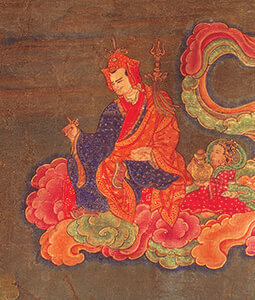
The Guhyagarbha Tantra: A Reader's Guide to the Glorious Secret Essence

The Life and Visions of Yeshe Tsogyal
See Also: Dudjom Tersar | Longchen Nyingtig | Namcho & Palyul
___________________
Guru Rinpoche | Mandarava | Rongzompa | Longchenpa | Jigme Lingpa | Patrul Rinpoche |
Sera Khandro | Mipham Rinpoche | Dilgo Khyentse | Dudjom Rinpoche
As Kyabje Dungse Thinley Norbu Rinpoche has said, "The ultimate source for the entirety of Sutra and Tantra is the King of Tantras, The Guhyagarbha, Glorious Secret Essence." The Guhyagarbha Tantra summarizes the heart of all eighteen great Mahayoga tantras and is the general tantra of the category of enlightened mind. This Secret Essence Tantra is the most advanced and extensively studied tantra within the Nyingma lineage; and its twenty-two chapters elucidate how to correctly view the ground, traverse the path, and ultimately reach the result-fully enlightened buddhahood.
The tantra of the Glorious Secret Essence (the Guhyagarbha Tantra) extracts the essence of the eighteen Mahayoga tantras and is also the general tantra of enlightened mind. The twenty-two chapters of this tantra describe the three tantras of the ground path and result and explain the topics of tantra needed to perfect the practice.
Studying the Secret Essence is crucial for all who seriously wish to learn any of the three inner tantras, as Mahāyoga is the foundation of all the inner tantras and the Secret Essence is the root tantra of Mahāyoga. The great Mipham writes, “One must learn the tantric trainings by relying on Mahāyoga, as it teaches the ground, path, and result of all tantric cycles.” He also says, “Correct understanding of the visions of all three inner tantras depends on understanding the Secret Essence.” The Secret Essence is also the source of numerous teachings on the one hundred peaceful and wrathful deities, one volume of which—the Tibetan Book of the Dead—is quite popular in the West.
Please note that many of the books listed here require that you have received certain teachings and/or empowerments. Please see the respective book pages for details. Until you receive them, the books are best used as something for your shrine.
Hardcover
$150.00 - Hardcover
The Guhyagarbha Tantra: Secret Essence Definitive Nature Just as It Is
By Longchenpa
Translated by Lama Chonam and Sangye Khandro
The twenty-two chapters of this tantra elucidate how to correctly view the ground, traverse the path, and ultimately reach the result—fully enlightened buddhahood.
The first part of this book includes the Tibetan and English translation for the root tantra itself.
The second part of this volume is a translation of the extensive com1nentary on The Guhyagarbha Tantra called Thorough Dispelling of Darkness throughout the Ten Directions written by the omniscient Longchenpa, who was an actual emanation of Samantabhadra. His word-for-word commentary gives uncommon explanations regarding all stages of Vajrayana practice, including comprehensive teachings from the Dzogchen point of view on how to practice and accomplish the path to enlightenment. The author includes complete explanations of the peaceful and wrathful mal).cJalas, as well as practical instructions needed to attain the four states of vidyadharahood.
We have two translations of Mipham Rinpoche's famous commentary on the Guhyagargbha:
Essence of Clear Light: An Overview of the Secret Commentary "Thorough Dispelling of Darkness throughout the Ten Directions"
By Jamgon Mipham Rinpoche
Translated by Lama Chonam and Sangye Khandro
This commentary on the Secret Essence by Mipham Rinpoche illuminates all the crucial points of the entire path of Secret Mantra Vajrayana. The teachings contained in Essence of Clear Light are not only useful for dharma practice in general but are especially applicable for the practice of the three innermost yogas of Secret Mantra. For that application there are the eleven topics well known throughout the teaching of tantra that are clearly elucidated in this text. The topics are: the nature as it is, the view immovable, samadhi forsaking the pass, conduct the array, mandala traversing the stages, empowerment not transgressing, samaya pursuing the goal, accomplishment presentation to the places, offerings the manifestation, enlightened activity binding, mudra and recitation, and mantra. These topics are the crucial points of the path through which the common and supreme siddhis are brought to fruition.
As Mipham Rinpoche points out in this commentary, if these topics are not understood, then there is no other method through which the final result on the path can be achieved. In brief, this excellent text brings an undeniable understanding that all dualistic phenomena arising from the ignorance of grasping and fixating are primordially pure as the truth of inseparable purity and evenness, or the great dharmakaya. Aside from realizing this view, there is no other method through which to receive the genuine wisdom transmission of the lineage of the vidyadhara masters. This doctrine of the great secret, the Guhyagarbha Tantra is the heart essence of a million wisdom dakinis and the path that was traversed by the accomplished vidyadharas of India and Tibet.
Hardcover
$95.00 - Hardcover
Hardcover | Ebook
$34.95 - Hardcover
Luminous Essence: A Guide to the Guhyagarbha Tantra
By Mipham Rinpoche
Translated by the Dharmachakra Translation Committee
Mipham's explanation of this text, here translated for the first time, is one of the most celebrated commentaries on the Tantra of the Secret Essence, which today occupies an important place in the tantric curriculum of Tibetan monastic colleges. Luminous Essence is a specialized guide meant for initiated tantric practitioners. To fully appreciate and assimilate its message, it should be studied under the guidance of a qualified teacher by those who have received the appropriate empowerments, reading transmissions, and oral instructions.
Key to the Precious Treasury
By Dodrupchen Jigme Tenpa'i Nyima
Translated by Lama Chonam and Sangye Khandro
As the author Dodrupchen Tenpa'i Nyima himself has said, this glorious Secret Essence Tantra possesses eight great features. It is the king of all tantras, pinnacle of all vehicles, origin of all doctrines, general commentary for all scriptural transmissions, core wisdom, intent of all the victorious ones, ultimate state of all results, path that all tathagatas have embarked upon, and great path of all true practitioners. Commentary to the Guhyagarbha Tantra, the Key to the Precious Treasury, synthesizes the meaning of all eighteen Mahayoga tantras from the perspective of the author's personal realization and authoritative scholarship. As the means through which serious practitioners can realize the truth of inseparable purity and evenness, this teaching is the guide for knowing how to internalize the Secret Mantra path of the generation and completion stages.
Th ere are a number of major commentaries3 on the Secret Essence; however, Ihas become one of the four most popular commentaries. It was written by the Third Dodrupchen, a highly
respected scholar and adept. Referring to the Third Dodrupchen’s famous treatise about memory, the Th irteenth Dalai Lama noted, “Today, a writer of this quality is very rare in this land.” The present Dalai Lama has frequently praised the Third Dodrupchen’s writings, too. He says, “Reading Dodrupchen was as if he were stroking my head in confirmation, giving
me confidence that my insight was not unfounded.”
Hardcover
$95.00 - Hardcover
Hardcover | Ebook
$59.00 - Hardcover
**Note: Books 15-17 is purchased as a single item but is in fact two separate books that ship wrapped together.
The Complete Nyingma Tradition from Sutra to Tantra, Books 15 to 17: The Essential Tantras of Mahayoga
By Choying Tobden Dorje
Translated by Gyurme Dorje
Contributions by Lama Tharchin
Two of the books of the Complete Nyingma Tradition, the masterpiece and most extensive presentation of the Nyingma thought and practice available in English, are focused on the Guhyagarbha Tantra. The two books present the entire text of the Guhyagarbha Tantra, in Tibetan and English, together with the interlinear sections of one of its most important commentaries, Dispelling the Darkness of the Ten Directions, by the outstanding fourteenth-century master Longchen Rabjam. Also included is Choying Tobden Dorje’s rewriting of Candragomin’s inspirational Extensive Commentary on the Sublime Litany of the Names of Manjushri.
Paperback | Ebook
$24.95 - Paperback
The Ri-me Philosophy of Jamgon Kongtrul the Great: A Study of the Buddhist Lineages of Tibet
By Ringu Tulku
Ringu Tulku provides several pages on the Guhyagarbha Tantra in his elucidation of the Ri-Me (Rimé) tradition, including its transmission from King Ja to his son Kukuraja to Lialitavajra and Buddhaguhya, who wrote the famous commentary, The Commentary on the Distinctions. Other Indian commentaries include those by Chandragomin and Guru Rinpoche (The Great Explanation by Padma).
The next section describes the Guhyagarbha teaching lineages in Tibet, highlighting masters like Vimalamitra, Ma Rinchen Chok, Nyak Jnanakumara, Nupchen Sangye Yeshe, Katog Dampa Desheg, Rongzompa, Longchenpa, the Zur lineages, and many more.
The following section delves into the three styles of teaching on the tantra:
- Teaching Like an Arrow Held at the Tip, which explains the entire ground, path, and fruition by using only the title of the text
- Teaching Like a Spear Held in the Middle, in which the cause is the view, characterized by understanding; the condition is the meditation, which is characterized by
engaging; and the result of treading the path is the four vidyadhara levels. - Teaching Like a Sword Held at the End, in which the whole tantra can be taught by grouping everything into the four ways of appearing: the way the ground nature appears, the deluded way that wrong understanding appears, the way the path appears for those to be tamed, and the way the result appears for the buddhas.
Hardcover | Ebook
$22.95 - Hardcover
A Garland of Views: A Guide to View, Meditation, and Result in the Nine Vehicles
By Padmasambhava and Mipham Rinpoche
A Garland of Views presents both a concise commentary by the eighth-century Indian Buddhist master Padmasambhava on a chapter from the Guhyagarbha Tantra on the different Buddhist and non-Buddhist philosophical views, including the Great Perfection (Dzogchen), and an explicative commentary on Padmasambhava’s text by the nineteenth-century scholar Jamgön Mipham (1846–1912).
Padmasambhava’s text is a core text of the Nyingma tradition because it provides the basis for the system of nine vehicles (three sutra vehicles and six tantra vehicles) that subsequently became the accepted way of classifying the different Buddhist paths in the Nyingma tradition.
Mipham’s commentary is the one most commonly used to explain Padmasambhava’s teaching. Mipham is well known for his prolific, lucid, and original writings on many subjects, including science, medicine, and philosophy, in addition to Tibetan Buddhist practice and theory.
Paperback | Ebook
$29.95 - Paperback
Establishing Appearances as Divine: Rongzom Chokyi Zangpo on Reasoning, Madhyamaka, and Purity
By Rongzom Chokyi Zangpo and Heidi Koppl
This is a translation and study of the great Rongzom Mahpandita's Establishing Appearances as Divine which is usually described in the present-day Nyingma tradition as a commentary on the Guhyagarbha Tantra. If one accepts this classification, it would lend further testimony to Rongzom’s general fondness for the Guhyagarbha teachings and his attempt to validate these teachings through the style of discourse usually associated with the classical dialectical approach. Considering that the initial thesis of Establishing Appearances
as Divine follows almost verbatim that of Padmasambhava in his Garland of Views, a treatise that itself is based on the Guhyagarbha, one may reasonably conclude that the
traditional classification of Establishing Appearances as Divine as a text pertaining to the Mahāyoga class of Tantra is valid.
Paperback | Ebook
$34.95 - Paperback
Jamgon Mipam: His Life and Teachings
By Mipham Rinpoche and Douglas Duckworth
The Guhyagabha Tantra (or Secret Essence Tantra) appears throughout this work since it is so central to the Nyingma tradition.
Here is an excerpt from one section, but there is a lot more in the book.
The Secret Essence Tantra is the most important tantra in the Nyingma tradition. It comes from a group of eighteen tantras known as the Māyājāla (“the magical net”). The metaphor of the net is significant; it is also used in a sutra where we find the famous image of the jeweled net of Indra, which is said to extend across the universe. It has a jewel at each point where the threads cross, and each jewel reflects each and every other jewel in the entire net. The net is a metaphor for the universe: the whole universe is contained within each single part. The finite is part of the infinite, while the infinite is constituted by and reflected within the finite. The metaphor aesthetically illustrates an important theme in Great Vehicle Buddhism in general and in tantra in particular, namely, the inseparability or unity of nirvana and samsara. Nirvana is not held as somewhere else out there, separate from samsara, like a separate and transcendent infinity apart from the finite. Rather, nirvana is to be discovered within the
nature of samsara. Likewise, the ultimate truth is not to be found separate from the relative truth but within it.In addition to containing the metaphor of the net, the Secret Essence Tantra also extends a theme of universal buddha-nature—the doctrine that all beings have the innate potential to become buddhas—to embrace a view that everything is already the buddha. Thus, the Secret Essence Tantra reveals an important turn within Buddhist thought: a shift from Buddhanature (tathāgata-garbha), the universal potential for enlightenment, to the secret-nature (guhya-garbha), the affirmation of universal enlightenment right now. This turn toward an immanent absolute is a major feature of the tradition of tantra in Tibet, as well as in Buddhist traditions across East Asia.
Paperback | Ebook
$34.95 - Paperback
Treasury of Precious Qualities: Book Two: Vajrayana and the Great Perfection
By Jigme Lingpa with commentary by Longchen Yeshe Dorje (Kangyur Rinpoche)
Translated by Padmakara Translation Group
The second volume of Jigme Lingpa's masterpiece relies heavily on the Guhyagarba Tantra in its presentation of Vajrayana and Dzogchen. It quotes liberally from it throughout.
Paperback | Ebook
$34.95 - Paperback
Matrix of Mystery: Scientific and Human Aspects of rDzogs-chen Thought
By Herbert V. Guenther
World-renowned Buddhist scholar Herbert V. Guenther here offers an early study study of the Dzogchen or Ati tradition of the Nyingma school of Tibetan Buddhism. Matrix of Mystery explores man's ability to preserve as well as transmit essential insights into the structure of reality.
Utilizing a key root Buddhist scripture, the Guhyagarbha ("Matrix of Mystery"), along with dozens of commentarial Tibetan textual sources, Guenther presents the most profound teachings of the Buddhist tradition, which represent the culmination of religious thought and practice in Tibet. In relating these teachings in modern scientific and humanistic perspectives, he demonstrates how, in many cases, the traditional religious and modern secular perspectives on the nature of reality interface.
Professor Guenther discusses the mandala and the deities that reside therein; the organizing principles of body, speech, mind, quality, and action, the three bodies of the buddha (trikaya); the inseparability of prajna and skillful means; and the complex field of Buddhist iconography. Throughout, quotations from numerous Tibetan sources are used to illustrate various teachings. His book will appeal to any serious student of Tibetan Buddhism.
Note: You may also find Khenpo Palden Sherab's Splendid Presence of the Great Guhyagarbha: Opening the Wisdom Door of the King of All Tantras a useful resource.
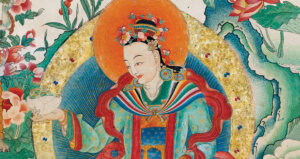
Yeshe Tsogyal: A Guide for Readers to the Dakini Princess

The Life and Visions of Yeshe Tsogyal
See Also: Dudjom Tersar | Longchen Nyingtig | Namcho & Palyul
___________________
Guru Rinpoche | Mandarava | Rongzompa | Longchenpa | Jigme Lingpa | Patrul Rinpoche |
Sera Khandro | Mipham Rinpoche | Dilgo Khyentse | Dudjom Rinpoche
The first Tibetan ever to attain complete enlightenment was in all probability the woman Yeshe Tsogyal, closest disciple of Padmasambhava, the master who introduced the Buddhist teachings to Tibet in the eighth century. The first three books below are not just biographies—and very different from each other both in emphasis as well as some of the events accounted for—but inspiring examples of how Buddha’s teaching may be practiced. Although these texts are of great antiquity, they nevertheless expresses a tradition that is still alive today and is an archetypal description of the teacher-disciple relationship. Yeshe Tsogyal follows the complete Buddhist path, including the Dzogchen teachings, and herself becomes a Guru of great power and wisdom. Passages of profound teachings are offset by episodes of exploit and adventure, spiritual endeavor, court intrigue, and personal encounter. Hers is a dramatic story, full of beauty and song, and offers an intimate glimpse of Tsogyal’s feelings, aspirations, hardships, and triumphs.
Biographical Accounts
Paperback | Ebook
$24.95 - Paperback
Lady of the Lotus-Born: The Life and Enlightenment of Yeshe Tsogyal
By Yeshe Tsogyal, Namkhai Nyingpo, and Gyalwa Changchub
Foreword by Jigme Khyentse Rinpoche
Translated by The Padmakara Translation Group
Lady of the Lotus-Born is a terma, or Dharma Treasure, written and concealed in the eighth century for future generations by the accomplished masters Namkhai Nyingpo and Gyalwa Changchub, the disciples of Padmasambhava and Yeshe Tsogyal. The text was discovered nearly a thousand years later in the seventeenth century by the Tertön (Dharma Treasure finder) Taksham Samten Lingpa, who, by interpreting the symbolic script of the dakinis (reproduced at the beginning of each chapter), revealed the text in its entirety as it has been handed down to us.
Paperback | Ebook
$24.95 - Paperback
The Life and Visions of Yeshe Tsogyal: The Autobiography of the Great Wisdom Queen
By Yeshe Tsogyal, rediscovered by Drime Kunga and Jamyang Khyentse Wangpo, and translated by Chonyi Drolma
Foreword by Dzongsar Khyentse Rinpoche
The many layers of the heroic life of Yeshé Tsogyal, Tibet’s best-known dakini and female master, are revealed in this inspiring work. Translated here for the first time, this terma, or “hidden treasure,” presents an outer narrative of her birth, family, and struggles in a traditional male-dominated society; an inner account of her meetings with the great master Padmasambhava; and a secret chronicle of her retreat at Chimpu and her visionary journey to Oddiyana. This accomplished translation is enriched by the refreshing insights of six contemporary scholars and teachers of Tibetan Buddhism, making this invaluable guide to the life of Yeshé Tsogyal a treasure for practitioners, scholars, and anyone intent on the possibility of awakening.
You can read a piece from the book Judith Simmer-Brown wrote here.
Sky Dancer: The Secret Life and Songs of the Lady Yeshe Tsogyel
By Taksham Nuden Dorje, translated by Keith Dowman
Foreword by Thinley Norbu Rinpoche
Another terma text is this extraordinary work, discovered by Taksham Nuden Dorje n the seventeenth century.
An Thinley Norbu Rinpoche says in the foreword,
Those who read the biography of the supreme tantric master, Padma Sambhava, and his Consort, Yeshe Tsogyal, have the chance to identify with them, and those who cultivate the inner wisdom Dakini:, the root Dakini:, progress towards becoming the supreme Sky Dancer, incomprehensible feminine wisdom,
the lover without motive.
and
In the dharmakaya's stainless space Yeshe Tsogyel is Kuntuzangmo, infinite and noble femininity itself. These names and qualities are no more than
indications of the nature of the dharmakaya which can never be contained in, or identified by, concepts. Sambhogakaya is the
glowing awareness of the dharmakaya, where the Five Buddhas and their Consorts appear as unobstructed luminous space-form. As the feminine aspect in the sambhogakaya, Yeshe Tsogyal is the Five Wisdom-Consorts.
Books Related to Khandro Yeshe Tsogyal
Paperback | Ebook
$24.95 - Paperback
by Nyoshul Khen Rinpoche
Translated and introduced by David Christiansen
Nyoshul Khen Rinpoche was one of the most important teachers of the 20th century - an important teacher to some of the best living teachers. In the pages of this book, Yeshe Tsogyal appears throughout. Here is one section:
At present we are practicing the meditation deity in the form of the dakini, from the terma treasure teachings of the second Dudjom Rinpoche, Jigdral Yeshe Dorje (1904–87). It is a teaching that has been revealed specifically for the benefit of beings in this dark age. This practice stems from the compassion of the three jewels and the blessings and aspirations of the buddhas and is an actual method to accomplish Guru Padmasambhava’s consort Yeshe Tsogyal. The dakini Yeshe Tsogyal is the nirmanakaya emanation of dharmadhatu Samantabhadri, the consort of the dharmakaya buddha Samantabhadra, who is the female aspect of the ultimate deity (don gyi lha).
In order to help us realize this state for ourselves, through the power, blessings, and aspirations of Buddha Samantabhadra and consort, the dakini Yeshe Tsogyal arises as their actual manifestation and is born into this world. Yeshe Tsogyal was blessed and taught by Guru Padmasambhava and as part of her various enlightened activities, she wrote down and transmitted a method to follow her and accomplish the essence of her awareness wisdom (rig pa’i ye shes kyi ngo bo). Thus we have the practice of Yeshe Tsogyal as a yidam or meditation deity.
Paperback | Ebook
$28.95 - Paperback
A Cascading Waterfall of Nectar
To call Cascading Waterfall a book on the preliminary practices is a bit like calling the Mt. Everest a hill. Coming from the vast wisdom mind of Longchenpa's emanation in our age, it is an indespensible guide to the path. And Yeshe Tsogyal, who Rinpoche describes as Kuntuzangmo appearing in form, appears throughout.
Rinpoche includes a translation of Mipham Rinpoche's prayer to Yeshe Tsogyal, The Longing Melody of Faith.
And the second part of the book is a commentary on the meaning of “The Continuously Blossoming Rosary of the Lotus Assembly Palace” called The Light Rays of the Youthful Sun and Rinpoche offers us many teachings on the Great Exaltation Queen Yeshe Tsogyal who features in the prayer.
Paperback | Ebook
$24.95 - Paperback
Inseparable across Lifetimes: The Lives and Love Letters of the Tibetan Visionaries Namtrul Rinpoche and Khandro Tāre Lhamo
By Namtrul Jigme Phuntsok and Khandro Tare Lhamo
Introduced and translated by Holly Gayley
Namtrul Jigme Phuntsok and Khandro Tare Lhamo were an extraordinary 20th century terton visionaries as the translations of love letters. Tare Lhamo is widely considered an emanation of Yeshe Tsogyal and this connection appears throughout Gayley's introduction as well as the letters themselves.
The letters are poetic, affectionate, and prophetic, articulating a hopeful vision of renewal that drew on their past lives together and led to their twenty-year partnership. This couple played a significant role in restoring Buddhism in the region of Golok once China’s revolutionary fervor gave way to reform.
Paperback | Ebook
$34.95 - Paperback
Light of Fearless Indestructible Wisdom: The Life and Legacy of His Holiness Dudjom Rinpoche
By Khenpo Tsewang Dongyal
This biography of Dudjom Rinpoche references Yeshe Tsogyal throughout. It includes the Seventh Heap of Lightbeams which a brief explanation of Kyabje Rinpoche’s enthronement as a great tertön and regent of Guru Padmasambhava and of how Guru Rinpoche and wisdom dakini Yeshe Tsogyal entrusted him with terma. Kenpo Tsewang also shares how in some terms teachings terma teachings it says that Guru Padmasambhava and Yeshe Tsogyal reincarnated together in the form of His Holiness Dudjom Rinpoche, so that he was their actual presence—only the body was different.
Paperback | Ebook
$39.95 - Paperback
This is a classic of scholarship on the Dakini principle from the point of view of a practitioner. Yeshe Togyal is discussed and referenced throughout. Here is a sample:
As for her inner dimension, Yeshe Tsogyal was remarkable because she was not merely a mortal; in her dynamic nature she was a tantric Buddhist meditational deity. She is called Sarasvati (Yangchenma), the great female bodhisattva of learning, culture, and music, the peaceful consort of Manjusri, who carries a lute that serves as her symbol. Sarasvati is also called Vakisvari, (Ngawang Lhamo) or ‘‘lady of speech’’ for her connection with seed syllables, music, utterance, and poetry. She is the dakini of the mirrorlike wisdom, and the ‘‘white-cloaked lady’’ (Ko Karmo) who is dakini of inner heat in the yogic practice of tummo. It is said that Yeshe Tsogyal was Sarasvati in her previous life.
Yeshe Tsogyal in her visionary dimension was the radiant White Tara (Drolma Karmo) the savior who, with her compassionate seven eyes, attends to the health and welfare of beings in all quarters. In another manifestation, she was Vajrayogini or Vajravarahi, who are two aspects of the most important dakini in the Tibetan tantric system. Vajrayogini is a semiwrathful deity, depicted as red and dancing, wearing bone ornaments; she is the most expressive of the qualities of wakefulness, the personification
of the widsom-mind itself. In her alternate identity as Vajravarahi she is the ‘‘Vajra Sow,’’ the manifestation of the nonconceptual quality of the mind, who severs thought with her hooked knife
Additional Resources

SNOW LION NEWSLETTER ARCHIVE
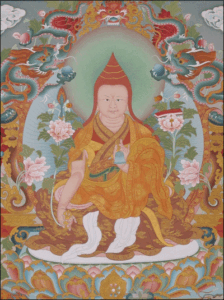
Mipham Rinpoche on the Strength of Mantras
Luminous Essence is a complete introduction to the world of tantric thought and practice. Composed by the renowned Tibetan master Jamgön Mipham (1846–1912), the text provides an overview of the theory and experiential assimilation of a seminal tantric scripture, the Tantra of the Secret Essence (Guhyagarbha Tantra).
Embodying the essence of tantric practice, this text has been a central scripture in Tibetan Buddhism for well over a thousand years. Mipham's explanation of this text, translated here for the first time, is one of the most celebrated commentaries on the Tantra of the Secret Essence, which today occupies an important place in the tantric curriculum of Tibetan monastic colleges.
$34.95 - Hardcover
By: Dharmachakra Translation Committee & H.H. the Fourteenth Dalai Lama & Jamgon Mipham
An excerpt from Luminous Essence
One may wonder whether or not the mantras created by the buddhas and those created by Brahma and other such figures are equal in strength. There is a difference between these two categories from the point of view of appearance, as the former are blessed by the buddhas to benefit those in need of guidance. Those mantras that are determined to be such by valid scriptures are unparalleled.
One may further object that since all sounds are symbolic gateways to complete liberation, the number of mantras taught with respect to those in need of guidance should also be limitless. Moreover, since the root letters are blessed, all that is derived from such syllables would be said to be mantra.
Yet again, since the Buddha’s enlightened speech, in all its various forms, knows no partiality or bias, everything would be enlightened speech. If this is the case, the objection goes, why should mantra recitation have different effects than ordinary chatter and so forth?
Mantras, however, are believed to be divine and are recited with faith for this reason, whereas this is not the case with other forms of speech. Moreover, if a mantra is thought to be something ordinary and not seen for what it is, it will not be able to perform its intended function.

Mantras are like nonconceptual wish-fulfilling jewels. Infusing one’s being with the blessings of mantra, like the form of a moon reflected on a body of water, necessitates the presence of faith and other conditions that set the stage for the spiritual attainments of mantra. Just as the moon’s reflection cannot appear without water, mantras cannot function without the presence of faith and other such factors in one’s being.

Photo by Alison Wright from The Spirit of Tibet
Nevertheless, this is not to say that simply hearing the sound of the Thus-gone One’s awareness mantras through the power of the inconceivable emanations of the Buddha is completely pointless.
The Fundamental Intent of Mañjuśrī explains:
Reciting the mantras of the thus-gone ones
Is, in this way, beneficial.
Even those who throw a glance,
Will become followers
Therefore, from the perspective of the way things appear conventionally, blessings occur once the mantras of the Buddha’s teachings come together with one’s own devoted interest. Because the right causes and conditions have been assembled, blessings do indeed arise, just as a sprout will shoot up once a seed, water, and the other necessary conditions are in place, and like the blessings that occur when an individual with a pure being meets with a disciple who sees him or her as realized.
-Composed by the renowned Tibetan master Jamgön Mipham (1846–1912)
Luminous Essence is a specialized guide meant for initiated tantric practitioners. To fully appreciate and assimilate its message, it should be studied under the guidance of a qualified teacher by those who have received the appropriate empowerments, reading transmissions, and oral instructions.

Jamgon Mipham (1846–1912), one of the great luminaries of Tibetan Buddhism in modern times, has had a dominant and vitalizing influence on the Nyingma School and beyond. He was an important member of the Rimé, or nonsectarian movement, which did much to strengthen and preserve the entire tradition.
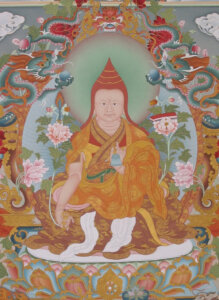
Ju Mipham Rinpoche or Jamgön Mipham Gyatso (1846-1912) was one of the most renowned Nyingma masters of his time.
To learn more about Mipham Rinpoche see
Books by Mipham Rinpoche

Jamgon Mipham on Enlightened Activity
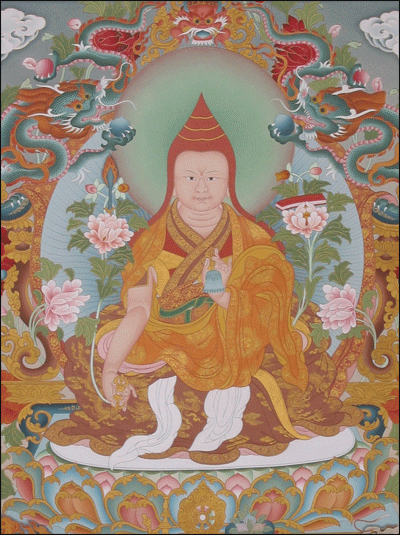 From the Snow Lion Archive
From the Snow Lion Archive
Enlightened Activity by Jamgön Mipham
We’re all aiming to bring our actions more and more in accord with enlightenment. This excerpt from Luminous Essence by Jamgön Mipham offers a map of how that might look.
In terms of its goal, enlightened activity can be either supreme or common. Supreme enlightened activity involves planting the seed of liberation in another’s being by initiating him or her into a mandala, using mantras and mudras, or by other such means. Common enlightened activities include everything that brings about a pleasant, albeit temporary, result.
When divided in terms of support, enlightened activities may utilize either external substances or the internal body, speech, and mind. There are innumerable activities that utilize various external substances. Such substances include drawings of magical circles, fire offerings, stupas, statues, symbolic implements, corpses, and the five meats. Activities may also be accomplished using physical mudras, dances, expressions, gazes, postures, and other such actions; by verbally reciting mantras, singing, uttering words of truth, and so on; and mentally through intention and absorption. Moreover, enlightened activities may be carried out by utilizing each of these individually or by using them all in conjunction with one another. By carrying out the activities of mantra in harmony with the mind-sets of sentient beings, one will be able to accomplish both temporal and ultimate aims. Hence, when classified further in terms of internal divisions and the aims of the activity, the varieties of enlightened activity are limitless.
In terms of essence, there are four types of enlightened activity that either benefit or annihilate: pacifying, enriching, magnetizing, and subjugating. Pacifying activities include pacifying illness, malevolent forces, negativity, obscurations, enemies, fears, obstacles, black magic, and so forth. Enriching activities are designed to cause lifespan, merit, wisdom, splendor, retinue, wealth, strength, prosperity, happiness, dharma, and other such factors to flourish. Magnetizing activities are used to bring something or someone under one’s control. This may include humans, such as kings, ministers, queens, or scholars; nonhuman beings, including gods, serpent beings, and malevolent spirits; glory, such as experience, realization, and enlightened qualities; and material goods like food, drink, clothing, and jewelry. There are various forms of subjugating activity as well. These include summoning, separating, binding, suppressing, averting, killing, and expelling; terrorizing, such as destroying something or driving someone insane; and creating bad omens, lightning, hail, and so on.
In terms of qualities, any act may be ordinary or supreme. The former refers to acts motivated by the three poisons, such as attachment to one’s own welfare. In essence, such acts are not embraced with the purposeful activity of skillful methods, nor do they lead to a meaningful result, either temporarily or ultimately. Though they may look like mantric activities on the surface, in truth they are ordinary acts. In this context, such acts are to be avoided.
Supreme activities, in contrast, are directed toward the welfare of others and are motivated by great compassion. In essence, they are characterized by the intent and conduct of mantra, which are embraced by extraordinary methods and knowledge. The results of such acts are deeply meaningful on both a temporal and ultimate level and are accomplished with ease.
Those knowledge holders who swiftly accomplish Buddhahood for the welfare of all sentient beings may liberate the enemies and obstructive forces that create obstacles on their path. They may also accomplish activities that pacify their own illnesses and so forth, thereby directly benefiting themselves and indirectly benefiting others. Because they are embraced by profound intent and conduct, such acts are not inferior in terms of their cause, essence, or fruition.
On the other hand, this is not the case with other acts, such as reversing mantras directed at the personal enemies of the three jewels. Though such acts may seem to benefit others in a temporary sense, in terms of their cause, essence, and fruition they are in line with ordinary acts. Hence, they should be avoided.
Therefore, knowledge involves knowing the right time to initiate an act, such that it does not conflict with the path; knowing how to carry out the act; and being skilled when it comes to transforming the result of the activity into the path of enlightenment. Method, on the other hand, is the supreme strength needed to carry out the activity, which may be mantra, mudra, or otherwise, as well as embracing the act with the profound viewpoint and conduct of mantra. In this way, when embraced by both means and knowledge, accomplishing a given act with ease is the temporal result, while the gradual accomplishment of enlightenment is its ultimate fruition.
The activities of the buddhas also benefit and create happiness for sentient beings, both temporally and ultimately. Engaging in buddha activity means to not let such acts become something to hope for in the future, but instead to carry out such activities here and now by utilizing the skillful methods of mantra. Ordinary bodhisattvas, for example, are unable to directly benefit those who have amassed extremely negative karma or savages who have gone completely astray. Aside from merely making aspiration prayers to benefit them in the future, they will be powerless to help them. Here, however, the skillful method of wrathful liberation can be used to directly cut through the stream of negative karma. Similarly, one is able to use the methods of mantra to manifest pacifying and other forms of activity as well, and to do so just as one intends and aspires. This is the enlightened activity of secret mantra.
$34.95 - Hardcover
By: Dharmachakra Translation Committee & H.H. the Fourteenth Dalai Lama & Jamgon Mipham
Books by Mipham Rinpoche
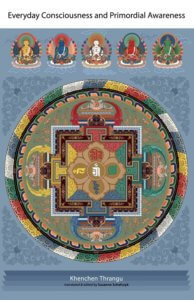
Thrangu Rinpoche Offers an Introduction to Buddhist Psychology
| The following article is from the Spring, 2002 issue of the Snow Lion Newsletter and is for historical reference only. You can see this in context of the original newsletter here. |
Everyday Consciousness and Buddha-Awakening
by Khenchen Thrangu Rinpoche
Translated and edited by Susanne Schefczyk
This introduction to Buddhist psychology supplies essential instructions for successful meditation practice. Khenchen Thrangu Rinpoche presents meditation practices that can powerfully influence and ultimately transform the mind into the purified mind of a Buddha. Rinpoche clearly describes how consciousnesses operate in everyday perception and how at the time of Buddhahood, these same consciousnesses express the five primordial wisdoms of the five Buddha families.
Khenchen Thrangu Rinpoche presents meditation practices that can powerfully influence and ultimately transform the mind into the purified mind of a Buddha.
Introduction by Thrangu Rinpoche:
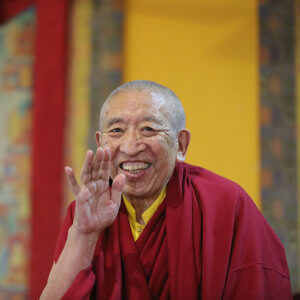
"I am particularly happy to have the opportunity here to explain the difference between everyday consciousness and the primordial awareness of the Buddhas. In my opinion, knowledge about the mind is very beneficial for everyone. Mind is designated as being composed of six, or sometimes eight, collections of consciousness. This is a very specific classification of mind as generally taught in Buddhist philosophy, but one which is comprehensible by means of inference.
Everyone who meditates including those who, for example, are visualizing the creation phase of a yidam deity will receive much greater benefit from the meditation if they know about the condition of mind. Whoever meditates on calm abiding (Skt. shamatha) should, while doing so, be clear about, what the resting mind' actually is, and how it may be generated. For the meditation on deep insight (Skt. vipaśyanā) of the great seal (Skt. Mahāmudrā) or of the great perfection (Skt. Mahāsaṅdhi), it is likewise of great benefit to know what the mind is composed of, what its innate essence is, and through which forms of expression it makes itself manifest
Studying this topic is also beneficial for those who are interested in Western psychology and psychotherapy. Some psychologists conscientiously study the mind's mode of being according to the teachings of Buddhism. They are very much interested in the divisions of mind into six or eight kinds of consciousness and how these consciousnesses function.
Knowledge about the five kinds of primordial awareness is also important, since this is the fruit that all practicing Buddhists aspire to bring forth through their meditation and dharma practice. The fruit of this practice is to reveal the ultimate primordial awareness. Since meditation takes us gradually closer to this result, it is important to know about what results may be attained.
Though the highest, ultimate result of our dharma practice is the state of a Buddha, this does not mean that we leave off being present to ourselves and our situation and pass over to somewhere else entirely. Nor are we to be concerned with developing extraordinary powers to boast about or with which to show off. Instead it is a case of revealing the primordial awareness that is primordially present within ourselves. It reveals itself through the gradual development of the three kinds of highest understanding (Skt. prajñā): that arisen through listening, that arisen through reflecting, and that arisen through meditating. When these three are completely and perfectly developed, the primordial awareness is fully revealed.
Due to the influence of primordial awareness expanding, the stains of ignorance and obscuration become purified, and we attain the ultimate fruit that in Sanskrit is called Buddha. The Tibetan equivalent of this designation is Sangyé (Wyl. sangs rgyas), purified and expanded. The actual meaning of Buddha is merely Gyé, expanded. The Tibetan translators, however, added the syllable Sang, purified, in order to indicate that due to primordial awareness revealing itself all the obscurations are purified. Thus in Tibetan the designation Buddha in both its aspects, that of purification and that of expansion, points to primordial awareness.
The method to expand the primordial awareness consists principally of engaging in meditation. Therefore, in order to practice and meditate correctly, we should first of all understand what primordial awareness is and how it reveals itself. This knowledge can be attained through the highest understanding of listening and reflecting.
When Buddha Shakyamuni introduced the Buddhist teachings (Skt. Dharma) he taught extensively on the subject of the mind. In the context of the lesser vehicle (Skt. Hīnayāna), when explaining the five aggregates, the twelve sense-sources, and the eighteen elements (eighteen Dhātus), the Buddha explained the mind in terms of six collections of consciousness: eye, ear, nose, tongue, and body consciousness (i.e. the five sense consciousnesses), and the mind consciousness.
the absorbing consciousness is profound and subtle.
In the context of the great vehicle (Skt. Mahayana), however, Buddha Shakyamuni explained the mind in terms of the eight collections of consciousness: the seventh consciousness is the kleśa-mind and the eighth the all-base consciousness (Skt. ālayavijñāna). The reason why these two types of consciousness were not taught in the lesser vehicle is explained in the sutras. There it says, the absorbing consciousness is profound and subtle. If it were taken to be the self, that would not be appropriate. The all-base consciousness functions uninterruptedly, like the flow of a river, by absorbing imprints as seeds.
In many non-Buddhist philosophies for example, that of the Indian Tirthikas the true existence of a self is postulated. It could happen that the followers of such philosophies take the all-base consciousness to be the truly existent self; this is a mistake. In the great vehicle, however, there is no entity as such that could be viewed as the self: indeed, there is no valid cognition that could prove the true existence of such a self. Since sometimes the body is taken to be the self and sometimes also the mind, there is no definite focal point for the self. It obviously follows that the self cannot be construed as being the all-base consciousness either.
the functions of the eight kinds of consciousness. . . . the way they can be transformed into the five kinds of primordial awareness. . . . how the ultimate fruit, the level of the five Buddha-families, can be attained.
When the Buddha's teaching spread throughout India, many Indian scholar's (Skt. pandita) wrote commentaries. When Buddhism later came to Tibet, Tibetan scholars also wrote commentaries concerning the functioning condition of the mind. Explanations of the most important points describing the functions of mind were given by Karmapa Rangjung Dorje in his text The Commentary that Distinguishes Consciousness from Primordial Awareness. In addition, Mipham Rinpoche addressed the same topic in his text Gateway to Knowledge. Both these texts describe the functions of the eight kinds of consciousness, the way they can be transformed into the five kinds of primordial awareness, and how the ultimate fruit the level of the five Buddha-families can be attained.
Concerning the transformation of the eight consciousnesses into the five kinds of primordial awareness, however, the authors each emphasize different aspects. Karmapa Rangjung Dorje emphasizes the seventh consciousness by dividing it into two kinds: the immediate mind and the klesha-mind. Mipham Rinpoche, however, describes the all-base consciousness in much more detail by discriminating between the all-base and the all-base consciousness.
When I was seventeen years old I studied Mipham Rinpoche's text very intensely. At such a young age one learns very well, and this is why I still remember his interpretation very clearly today. The following explanations are therefore in accordance with Mipham Rinpoche's text Gateway to Knowledge.
Related articles:
For more information:

Everyday Consciousness and Primordial Awareness
$24.95 - Paperback
Also see our Reader's Guide to Khenchen Thrangu Rinpoche which explains this text in the context of his many works.
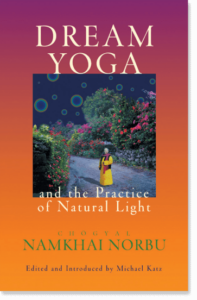
Dream Yoga and the Practice of Natural Light
| The following article is from the Spring, 2002 issue of the Snow Lion Newsletter and is for historical reference only. You can see this in context of the original newsletter here. |

by Chogyal Namkhai Norbu, ed. & intro. by Michael Katz.
This revised and enlarged edition includes additional material from a profoiuid and personal Dzogchen book which Chogyal Namkhai Norbu has been writing for many years. This material expands and deepens the first edition's emphasis on specific exercises to develop awareness within the dream and sleep states.
Rinpoche gives instructions for developing clarity within the sleep and dream states. He goes beyond the practices of lucid dreaming that have been popularized in the West, by presenting methods for guiding dream states that are part of a broader system for enhancing self-awareness called Dzogchen. In this tradition, the development of lucidity in the dream state is understood in the context of generating greater awareness for the ultimate purpose of attaining liberation.
Also included in this book is a text written by Mipham, the nineteenth- century master of Dzogchen, which offers additional insights into this extraordinary form of meditation and awareness.
Chogyal Namkhai Norbu Rinpoche is one of the greatest Tibetan meditation masters and scholars teaching in the West today. His luminous Dream Yoga teachings are invaluable. I myself read this book with great interest, and recommend it to my own students.Lama Surya Das, author of Awakening the Buddha Within
Chogyal Namkhai Norbu is a Tibetan master of the Dzogchen tradition. He has authored many books including The Crystal and the Way of Light, The Supreme Source, and Dzogchen: The Self-Perfected State.
The following is an excerpt from the chapter The Practice of the Night from Dream Yoga and the Practice of Natural Light.
When we start to dream, as previously mentioned, we may have one of two general types of dreams. One type is karmic dreams and the other is dreams of clarity. In addition to those dreams reflecting karma from our current life, karmic dreams can also be linked to our past lives.
The other type of dreams are dreams of clarity. Why do we have dreams of clarity? Because everybody, since the beginning, has infinite potentiality; that is a quality of the natural mind that we all possess. Sometimes, even if we are not doing a particular practice, a dream of clarity will manifest because we have that nature. If you are doing the practice of the night and becoming more familiar with it, then not only occasionally, but on a regular basis, you will become familiar with manifestations of dreams of clarity.
You may now understand what the theory is and its importance. Now I will explain how you practice it.
If you are an agitated person, then before you go to sleep, you can do a little deep breathing to regulate the flow of air and calm yourself. Then concentrate on a white Tibetan syllable at the center of your body. If you prefer an English A, it is acceptable. The important thing is that it corresponds in your mind to the sound ahh. It is important that when you see that letter, you automatically know what its sound is.
If you do not succeed in concentrating and seeing this US at first, it may be that you do not know how to visualize. Try writing an US on a piece of paper, put it in front of you and stare at it for a while. Close your eyes and this 1*1 will appear before your mind immediately. In this way you will get a more precise image.
So, you try to concentrate on this white 1*1. Or you fix on the presence of this white US, and you stay with it as long as you can.
You can also do a kind of training to have greater precision in feeling this presence: imagine that from the central US, which is viewed at heart level within your body, a second arises, and from the second, a third arises, until you can see a chain of USs going up to the crown of the head. Then you visualize these USs coming back down. You can repeat this a number of times if you do not fall asleep immediately. Whenever you have difficulty in feeling the presence of the it is very useful and important to do this chain. This is a way of charging your clarity.
The most important point is that when you fall asleep, you try to have this 1*1 present. Initially, it should be accurate and sharp; afterwards, you relax. Relaxing does not mean you drop the 1*1 or that you give it up. You retain a sense of its presence, and you relax, and thus you fall asleep. You should try to do the practice of natural light each night, just as you should try to be in the state of contemplation continually. For every moment and every activity there are ways to do Dzogchen practice. If, however, Dzogchen practice of the night is difficult for you, and you have had more experience doing Tantric style dream practice, and you have had an initiation on a particular deity, then perhaps it would be useful for you to continue with your Tantric practice. For example, if you do the practice of Vajrayogini, then upon sleeping, you should try to visualize a very tiny Vajrayogini at the center of your body. We call this tiny being Jnanasattva, which means wisdom manifestation.

If you are doing the practice of the night and I becoming more familiar with it, then not only occasionally, but on a regular basis, you will become familiar with manifestations of dreams of clarity.
You keep this presence and continue your sleep. There are other visualization practices similar to Guruyoga in tantric dream practices. For example, you might visualize Vajradhara as the unification of all your gurus and manifest that visualization in the center of your body. You would keep the presence of this visualization, relax, and slowly, slowly go to sleep. Because these are tantric exercises, you should practice only the special instructions you receive from your master.
By contrast, in Dzogchen we generally do the visualization of the white as described above, for the purpose of coordinating the energy. We visualize the white 1*1 at the center of the body. After having manifested this white, luminous US, we slowly relax. We relax slowly but completely when we do this visualization so as not to have tension. If we do not relax completely, we will be unable to sleep. We must spontaneously manifest the white US without thinking, without creating, and then relax all effort and go to sleep.
In order to remind yourself to visualize this white US and to do the Dzogchen practice of the night, it is very useful to put a picture or a sign of a white US near your bed. No one will know what it is; perhaps they will think it is a piece of artwork. You, however, will know its precise function.
It is also very important to remember the practice of the white when you awaken in the morning. If possible, you may sound ahh immediately. If you cannot sound loudly because there is someone else sleeping, it is enough that you exhale with ahh. As long as you can hear yourself and feel the presence of that white this is a method of Gurayoga, It is not necessary to say many words or prayers; simply having the presence of the white ifcj and recognizing that the is the unification of the mind of all your gurus is sufficient. Then you integrate this into a state of contemplation, or rigpa.
Starting your morning yoga in this way is wonderful and will help you very much with all your practices and particularly your practice of the night. There is a kind of a connection that you make by remembering the white US when you are going to sleep and, then again, in the morning.

